Freescale Semiconductor ZT2 ZStar Triaxial Accelerometer User Manual DRM078
Freescale Semiconductor, Inc. ZStar Triaxial Accelerometer DRM078
manual

freescale.com
Wireless Sensing Triple Axis Reference design
(ZSTAR) Designer Reference Manual
ZSTARRM
Rev. 0.9
8/2006
USA:
This device complies with Part 15 of the FCC Rules.
Operation is subject to the following two conditions:
(1) this device may not cause harmful interference,
and (2) this device must accept any interference
Canada:
This Class [*] digital apparatus complies with Canadian ICES-003.
Cet appareil numériqué de la classe [*] est conformé à la norme NMB-003 du Canada.
Europe:
TBD
Warning:
Any changes or modifications to this device not expressly approved by the party responsible for
compliance could void the user's authority to operate the equipment.

Wireless Sensing Triple Axis Reference design, Rev. 0.9
Freescale Semiconductor 3
Wireless Sensing Triple Axis Reference design
Designer Reference Manual
by: Pavel Lajšner and Radomír Kozub
Freescale Czech Systems Laboratories
Rožnov pod Radhoštěm, Czech Republic
To provide the most up-to-date information, the revision of our documents on the World Wide Web will be
the most current. Your printed copy may be an earlier revision. To verify you have the latest information
available, refer to:
http://www.freescale.com
The following revision history table summarizes changes contained in this document. For your
convenience, the page number designators have been linked to the appropriate location.
Revision History
Date Revision
Level Description Page
Number(s)
May,
2006 0.02 First draft N/A
July
2006 0.9 Language correction, minor updates N/A

Revision History
Wireless Sensing Triple Axis Reference design, Rev. 0.9
4Freescale Semiconductor

Wireless Sensing Triple Axis Reference design, Rev. 0.9
Freescale Semiconductor 5
Table of Contents
Chapter 1
Introduction
1.1 Introduction . . . . . . . . . . . . . . . . . . . . . . . . . . . . . . . . . . . . . . . . . . . . . . . . . . . . . . . . . . . . . . . . . 9
1.2 MMA7260Q 3-axis Accelerometer Sensor. . . . . . . . . . . . . . . . . . . . . . . . . . . . . . . . . . . . . . . . . . 9
Chapter 2
Wireless Sensing Triple Axis Reference design introduction
2.1 Introduction . . . . . . . . . . . . . . . . . . . . . . . . . . . . . . . . . . . . . . . . . . . . . . . . . . . . . . . . . . . . . . . . 11
2.2 Featured products . . . . . . . . . . . . . . . . . . . . . . . . . . . . . . . . . . . . . . . . . . . . . . . . . . . . . . . . . . . 12
2.2.1 Triple Axis Accelerometer MMA7260Q . . . . . . . . . . . . . . . . . . . . . . . . . . . . . . . . . . . . . . . . 12
2.2.2 Microcontroller MC9S08QG8 . . . . . . . . . . . . . . . . . . . . . . . . . . . . . . . . . . . . . . . . . . . . . . . . 12
2.2.3 MC13191 2.4 GHz ISM Band Low Power Transceiver . . . . . . . . . . . . . . . . . . . . . . . . . . . . 13
2.2.4 Microcontroller MCHC908JW32. . . . . . . . . . . . . . . . . . . . . . . . . . . . . . . . . . . . . . . . . . . . . . 13
Chapter 3 Sensor Board description
3.1 Board overview . . . . . . . . . . . . . . . . . . . . . . . . . . . . . . . . . . . . . . . . . . . . . . . . . . . . . . . . . . . . . 15
3.2 A/D conversion of XYZ levels . . . . . . . . . . . . . . . . . . . . . . . . . . . . . . . . . . . . . . . . . . . . . . . . . . 17
3.2.1 ADC module init: . . . . . . . . . . . . . . . . . . . . . . . . . . . . . . . . . . . . . . . . . . . . . . . . . . . . . . . . . 17
3.2.2 ADC measurement. . . . . . . . . . . . . . . . . . . . . . . . . . . . . . . . . . . . . . . . . . . . . . . . . . . . . . . . 18
3.3 Power management. . . . . . . . . . . . . . . . . . . . . . . . . . . . . . . . . . . . . . . . . . . . . . . . . . . . . . . . . . 18
3.3.1 MC13191 power management features. . . . . . . . . . . . . . . . . . . . . . . . . . . . . . . . . . . . . . . . 20
3.4 ZSTAR Sensor Board hardware overview . . . . . . . . . . . . . . . . . . . . . . . . . . . . . . . . . . . . . . . . . 21
3.4.1 Analog connections . . . . . . . . . . . . . . . . . . . . . . . . . . . . . . . . . . . . . . . . . . . . . . . . . . . . . . . 21
3.4.2 g-select connections . . . . . . . . . . . . . . . . . . . . . . . . . . . . . . . . . . . . . . . . . . . . . . . . . . . . . . 21
3.4.3 BDM (Background Debug Mode) connections. . . . . . . . . . . . . . . . . . . . . . . . . . . . . . . . . . . 21
3.4.4 Sensor Board schematics . . . . . . . . . . . . . . . . . . . . . . . . . . . . . . . . . . . . . . . . . . . . . . . . . . 22
3.4.5 Button connections. . . . . . . . . . . . . . . . . . . . . . . . . . . . . . . . . . . . . . . . . . . . . . . . . . . . . . . . 23
3.4.6 MC13191 to MC9S08QG8 microcontroller interface . . . . . . . . . . . . . . . . . . . . . . . . . . . . . . 23
3.4.7 MC13191 RF interface. . . . . . . . . . . . . . . . . . . . . . . . . . . . . . . . . . . . . . . . . . . . . . . . . . . . . 23
3.4.8 Clocking options of MC9S08QG8 . . . . . . . . . . . . . . . . . . . . . . . . . . . . . . . . . . . . . . . . . . . . 24
3.4.9 LED indicators connections . . . . . . . . . . . . . . . . . . . . . . . . . . . . . . . . . . . . . . . . . . . . . . . . . 24
3.4.10 Power supply . . . . . . . . . . . . . . . . . . . . . . . . . . . . . . . . . . . . . . . . . . . . . . . . . . . . . . . . . . . . 25
3.5 Bill of Materials. . . . . . . . . . . . . . . . . . . . . . . . . . . . . . . . . . . . . . . . . . . . . . . . . . . . . . . . . . . . . . 26
Chapter 4 USB stick board description
4.1 Board overview . . . . . . . . . . . . . . . . . . . . . . . . . . . . . . . . . . . . . . . . . . . . . . . . . . . . . . . . . . . . . 27
4.2 ZSTAR USB stick Board hardware overview . . . . . . . . . . . . . . . . . . . . . . . . . . . . . . . . . . . . . . . 30
4.2.1 USB connections . . . . . . . . . . . . . . . . . . . . . . . . . . . . . . . . . . . . . . . . . . . . . . . . . . . . . . . . . 30
4.2.2 Power supply . . . . . . . . . . . . . . . . . . . . . . . . . . . . . . . . . . . . . . . . . . . . . . . . . . . . . . . . . . . . 30
4.2.2.1 Fixed voltage regulators . . . . . . . . . . . . . . . . . . . . . . . . . . . . . . . . . . . . . . . . . . . . . . . . . . 30

Table of Contents
Wireless Sensing Triple Axis Reference design, Rev. 0.9
6Freescale Semiconductor
4.2.3 MC13191 to MCHC908JW32 microcontroller interface . . . . . . . . . . . . . . . . . . . . . . . . . . . . 31
4.2.4 Oscillator and clocking options. . . . . . . . . . . . . . . . . . . . . . . . . . . . . . . . . . . . . . . . . . . . . . . 31
4.2.5 LED indicators connections . . . . . . . . . . . . . . . . . . . . . . . . . . . . . . . . . . . . . . . . . . . . . . . . . 31
4.2.6 Button connection . . . . . . . . . . . . . . . . . . . . . . . . . . . . . . . . . . . . . . . . . . . . . . . . . . . . . . . . 32
4.2.7 MON08 interface . . . . . . . . . . . . . . . . . . . . . . . . . . . . . . . . . . . . . . . . . . . . . . . . . . . . . . . . . 32
4.2.8 Optional serial interface . . . . . . . . . . . . . . . . . . . . . . . . . . . . . . . . . . . . . . . . . . . . . . . . . . . . 32
4.2.9 USB stick schematics. . . . . . . . . . . . . . . . . . . . . . . . . . . . . . . . . . . . . . . . . . . . . . . . . . . . . . 33
4.3 Bill of Materials. . . . . . . . . . . . . . . . . . . . . . . . . . . . . . . . . . . . . . . . . . . . . . . . . . . . . . . . . . . . . . 34
Chapter 5 Software Design
5.1 Introduction . . . . . . . . . . . . . . . . . . . . . . . . . . . . . . . . . . . . . . . . . . . . . . . . . . . . . . . . . . . . . . . . 35
5.2 SMAC (Simple Media Access Controller) . . . . . . . . . . . . . . . . . . . . . . . . . . . . . . . . . . . . . . . . . 35
5.2.1 SMAC Features . . . . . . . . . . . . . . . . . . . . . . . . . . . . . . . . . . . . . . . . . . . . . . . . . . . . . . . . . . 35
5.2.2 Modifications of SMAC for ZSTAR demo. . . . . . . . . . . . . . . . . . . . . . . . . . . . . . . . . . . . . . . 35
5.2.2.1 MC9S08QG8 SMAC modifications (Sensor Board) . . . . . . . . . . . . . . . . . . . . . . . . . . . . . 36
5.2.2.2 MCHC908JW32 SMAC modifications (USB stick) . . . . . . . . . . . . . . . . . . . . . . . . . . . . . . 36
5.2.2.3 Generic SMAC modifications (USB stick + Sensor Board). . . . . . . . . . . . . . . . . . . . . . . . 37
5.3 ZSTAR RF protocol . . . . . . . . . . . . . . . . . . . . . . . . . . . . . . . . . . . . . . . . . . . . . . . . . . . . . . . . . . 38
5.3.1 Zpacket format . . . . . . . . . . . . . . . . . . . . . . . . . . . . . . . . . . . . . . . . . . . . . . . . . . . . . . . . . . . 38
5.3.1.1 Network number . . . . . . . . . . . . . . . . . . . . . . . . . . . . . . . . . . . . . . . . . . . . . . . . . . . . . . . . 39
5.3.1.2 RX strength. . . . . . . . . . . . . . . . . . . . . . . . . . . . . . . . . . . . . . . . . . . . . . . . . . . . . . . . . . . . 39
5.3.1.3 Zcommand . . . . . . . . . . . . . . . . . . . . . . . . . . . . . . . . . . . . . . . . . . . . . . . . . . . . . . . . . . . . 39
5.3.1.4 Zdata . . . . . . . . . . . . . . . . . . . . . . . . . . . . . . . . . . . . . . . . . . . . . . . . . . . . . . . . . . . . . . . . 39
5.3.2 ZSTAR protocol Zcommand description . . . . . . . . . . . . . . . . . . . . . . . . . . . . . . . . . . . . . . . 40
5.3.2.1 ZSTAR_BROADCAST . . . . . . . . . . . . . . . . . . . . . . . . . . . . . . . . . . . . . . . . . . . . . . . . . . . 40
5.3.2.2 ZSTAR_CONNECT . . . . . . . . . . . . . . . . . . . . . . . . . . . . . . . . . . . . . . . . . . . . . . . . . . . . . 40
5.3.2.3 ZSTAR_DATA . . . . . . . . . . . . . . . . . . . . . . . . . . . . . . . . . . . . . . . . . . . . . . . . . . . . . . . . . 40
5.3.2.4 ZSTAR_ACK . . . . . . . . . . . . . . . . . . . . . . . . . . . . . . . . . . . . . . . . . . . . . . . . . . . . . . . . . . 41
5.3.2.5 ZSTAR_CALIB . . . . . . . . . . . . . . . . . . . . . . . . . . . . . . . . . . . . . . . . . . . . . . . . . . . . . . . . . 41
5.3.2.6 ZSTAR_STATUS . . . . . . . . . . . . . . . . . . . . . . . . . . . . . . . . . . . . . . . . . . . . . . . . . . . . . . . 41
5.4 STAR protocol and ZSTAR extensions (over USB). . . . . . . . . . . . . . . . . . . . . . . . . . . . . . . . . . 42
5.4.1 Communication handshake ‘R’ (0x52) . . . . . . . . . . . . . . . . . . . . . . . . . . . . . . . . . . . . . . . . . 42
5.4.1.1 Extended Communication handshake ‘r’ (0x72). . . . . . . . . . . . . . . . . . . . . . . . . . . . . . . . 42
5.4.2 Accelerometer data transfer ‘V’ (0x56). . . . . . . . . . . . . . . . . . . . . . . . . . . . . . . . . . . . . . . . . 42
5.4.2.1 Extended Accelerometer data transfer ‘v’ (0x76) . . . . . . . . . . . . . . . . . . . . . . . . . . . . . . . 43
5.4.3 Calibration data ‘K’ (0x4B) . . . . . . . . . . . . . . . . . . . . . . . . . . . . . . . . . . . . . . . . . . . . . . . . . . 43
5.4.4 Calibration process ‘k’ (0x6B) . . . . . . . . . . . . . . . . . . . . . . . . . . . . . . . . . . . . . . . . . . . . . . . 44
5.4.4.1 Remaining STAR demo commands . . . . . . . . . . . . . . . . . . . . . . . . . . . . . . . . . . . . . . . . . 44
5.4.5 Additional ZSTAR commands . . . . . . . . . . . . . . . . . . . . . . . . . . . . . . . . . . . . . . . . . . . . . . . 44
5.4.5.1 g-select reading ‘G’ (0x47) . . . . . . . . . . . . . . . . . . . . . . . . . . . . . . . . . . . . . . . . . . . . . . . . 44
5.4.5.2 g-select setting ‘g’ (0x67) . . . . . . . . . . . . . . . . . . . . . . . . . . . . . . . . . . . . . . . . . . . . . . . . . 45
5.4.5.3 Info ‘I’ (0x49). . . . . . . . . . . . . . . . . . . . . . . . . . . . . . . . . . . . . . . . . . . . . . . . . . . . . . . . . . . 45
5.4.5.4 Debug on ‘U’ (0x55) and Debug off ‘u’ (0x75) . . . . . . . . . . . . . . . . . . . . . . . . . . . . . . . . . 45
5.4.6 Further debug and test commands . . . . . . . . . . . . . . . . . . . . . . . . . . . . . . . . . . . . . . . . . . . 46
5.4.6.1 Forced channel number selection . . . . . . . . . . . . . . . . . . . . . . . . . . . . . . . . . . . . . . . . . . 46
5.4.6.2 Semiautomatic self-calibration . . . . . . . . . . . . . . . . . . . . . . . . . . . . . . . . . . . . . . . . . . . . . 46
5.5 Bootloader . . . . . . . . . . . . . . . . . . . . . . . . . . . . . . . . . . . . . . . . . . . . . . . . . . . . . . . . . . . . . . . . . 47

Wireless Sensing Triple Axis Reference design, Rev. 0.9
Freescale Semiconductor 7
5.5.1 Bootloading procedure. . . . . . . . . . . . . . . . . . . . . . . . . . . . . . . . . . . . . . . . . . . . . . . . . . . . . 48
5.5.2 Dualboot guidelines . . . . . . . . . . . . . . . . . . . . . . . . . . . . . . . . . . . . . . . . . . . . . . . . . . . . . . . 51
5.5.2.1 Dualboot applications switching . . . . . . . . . . . . . . . . . . . . . . . . . . . . . . . . . . . . . . . . . . . . 52
Chapter 6
Application Setup
6.1 ZSTAR Installation Procedure . . . . . . . . . . . . . . . . . . . . . . . . . . . . . . . . . . . . . . . . . . . . . . . . . . 53
6.1.1 USB stick installation . . . . . . . . . . . . . . . . . . . . . . . . . . . . . . . . . . . . . . . . . . . . . . . . . . . . . . 53
6.1.2 AN2295 Bootloader Drivers installation . . . . . . . . . . . . . . . . . . . . . . . . . . . . . . . . . . . . . . . . 60

Table of Contents
Wireless Sensing Triple Axis Reference design, Rev. 0.9
8Freescale Semiconductor
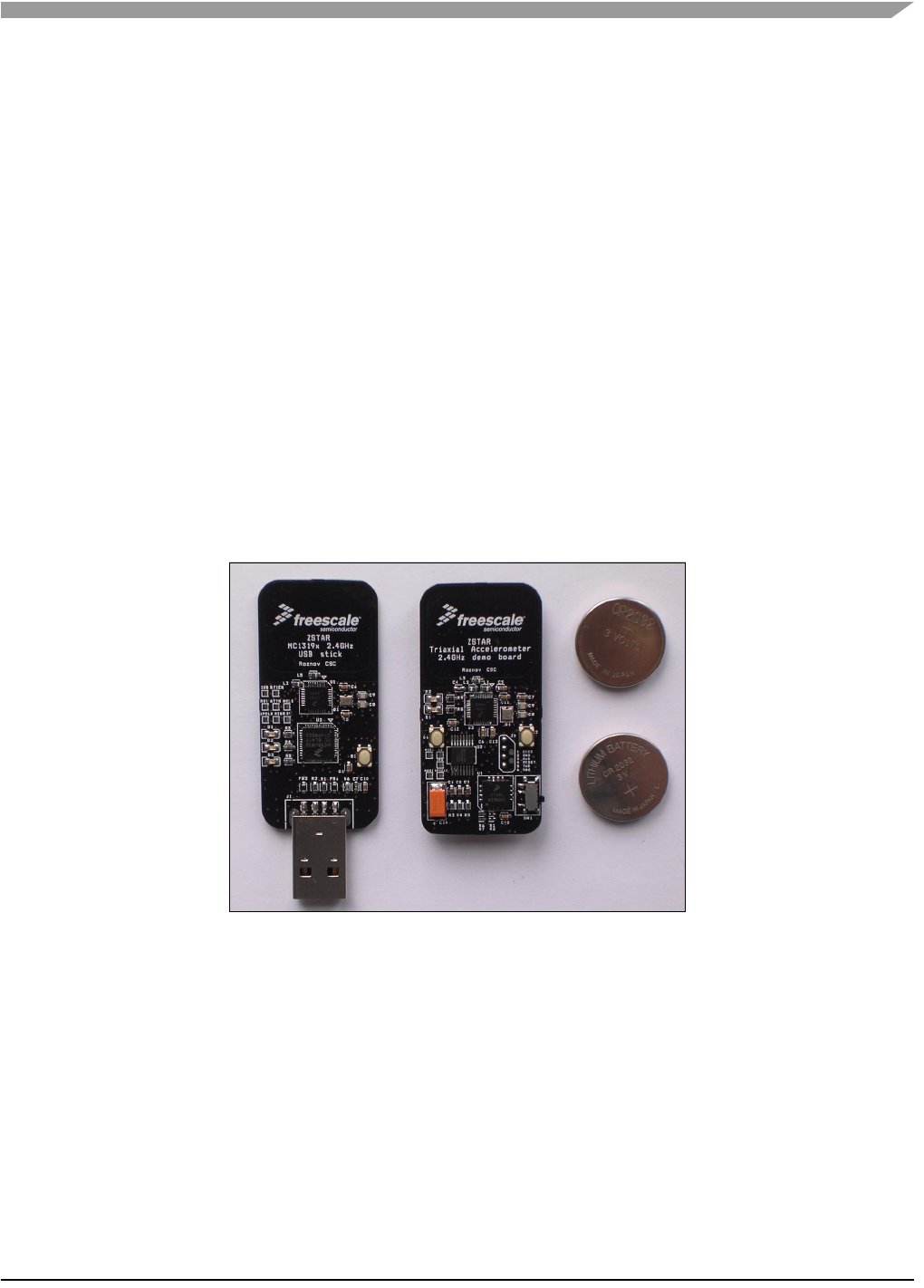
Wireless Sensing Triple Axis Reference design, Rev. 0.9
Freescale Semiconductor 9
Chapter 1
Introduction
1.1 Introduction
This paper describes the design of a Wireless Sensing Triple Axis Reference design (ZSTAR), a demo
for wireless demonstration of the 3-axis accelerometer MMA7260Q sensors from Freescale.
The reference design will enable you to see how Freescale's accelerometers can add additional
functionality to applications in various industries. The accelerometer measurements can be grouped into
6 sensing functions - Fall, Tilt, Motion, Positioning, Shock and Vibration - for multifunctional applications.
The RD3152MMA7260Q development tool offers robust wireless communication using the powerful,
easy-to-use 2.4GHz frequency MC13191 transceiver. Minor changes can be made with pin to pin
compatibility allowing implementation of the MC13192 and MC13193 for ZigBeeTM wireless applications.
Figure 1-1 ZSTAR Demo photo (CR2032 batteries for comparison)
1.2 MMA7260Q 3-axis Accelerometer Sensor
The MMA7260Q low cost capacitive micromachined accelerometer features signal conditioning, a 1-pole
low pass filter and temperature compensation, and g-Select, which allows a selection from 4 sensitivities.
Zero-g offset full scale span and filter cut-offs are factory set and require no external devices. This device
includes a sleep mode making it ideal for handheld battery powered electronics.

Introduction
Wireless Sensing Triple Axis Reference design, Rev. 0.9
10 Freescale Semiconductor
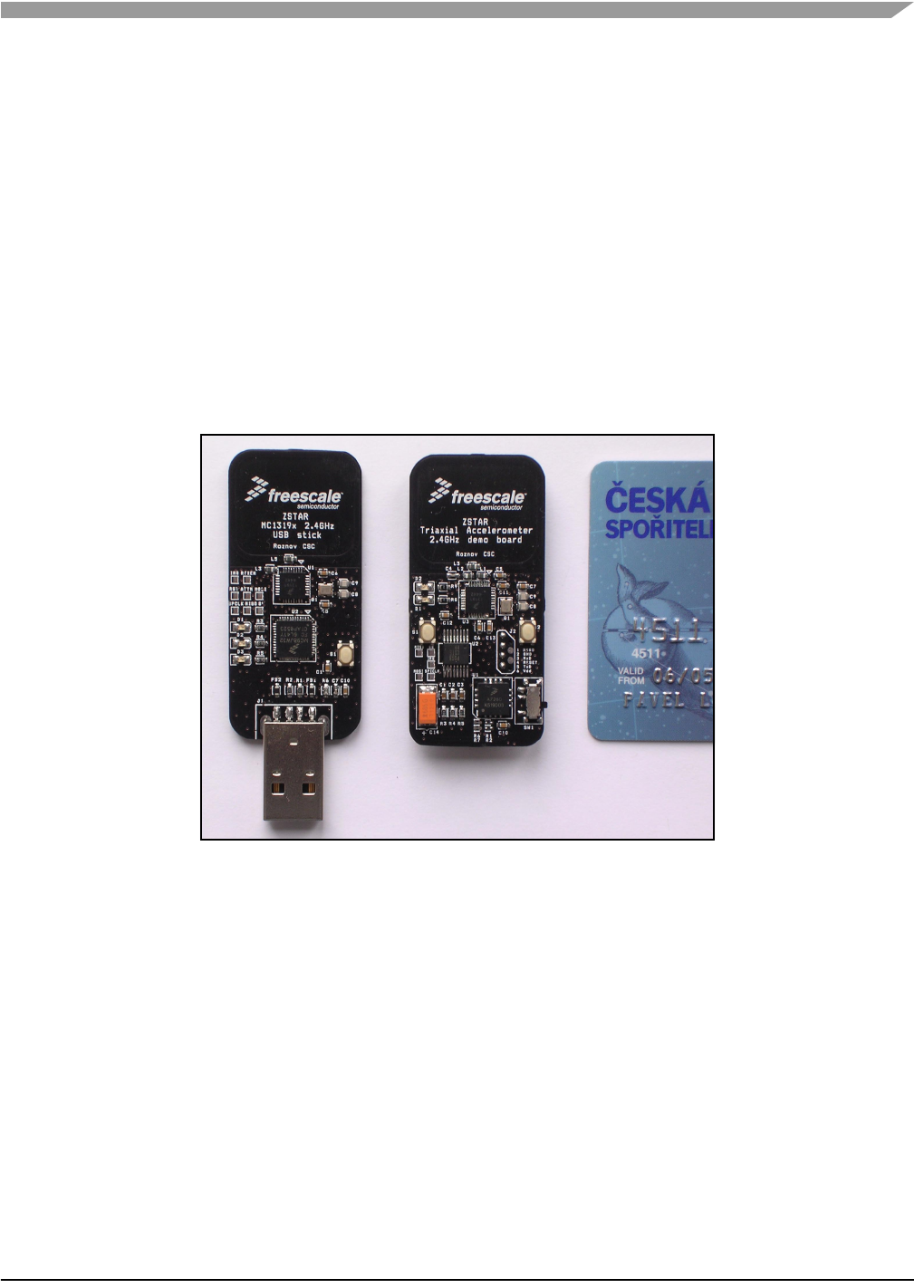
Wireless Sensing Triple Axis Reference design, Rev. 0.9
Freescale Semiconductor 11
Chapter 2
Wireless Sensing Triple Axis Reference design introduction
2.1 Introduction
The Wireless Sensing Triple Axis Reference design (ZSTAR) has been designed as a wireless
complement to the previous STAR (Sensing Triple Axis Reference design) RD3112MMA7260Q demo. A
2.4GHz radio-frequency (RF) link based on the low-cost MC13191 family is used for connection from the
sensor to PC, allowing the visualization of key accelerometer applications.
Figure 2-1ZSTAR demo overview
The demo consists of the two boards:
• Sensor Board (or remote board) containing the MMA7260Q 3-axis accelerometer, S08 family
MC9S08QG8 8-bit microcontroller and the 2.4GHz RF chip MC13191 for wireless communication.
• USB stick, again with the MC13191 RF front-end, and the HC08 family MCHC908JW32 for the
USB communication.
Both sides communicate over the RF medium utilizing the freely available software stack SMAC from
Freescale.
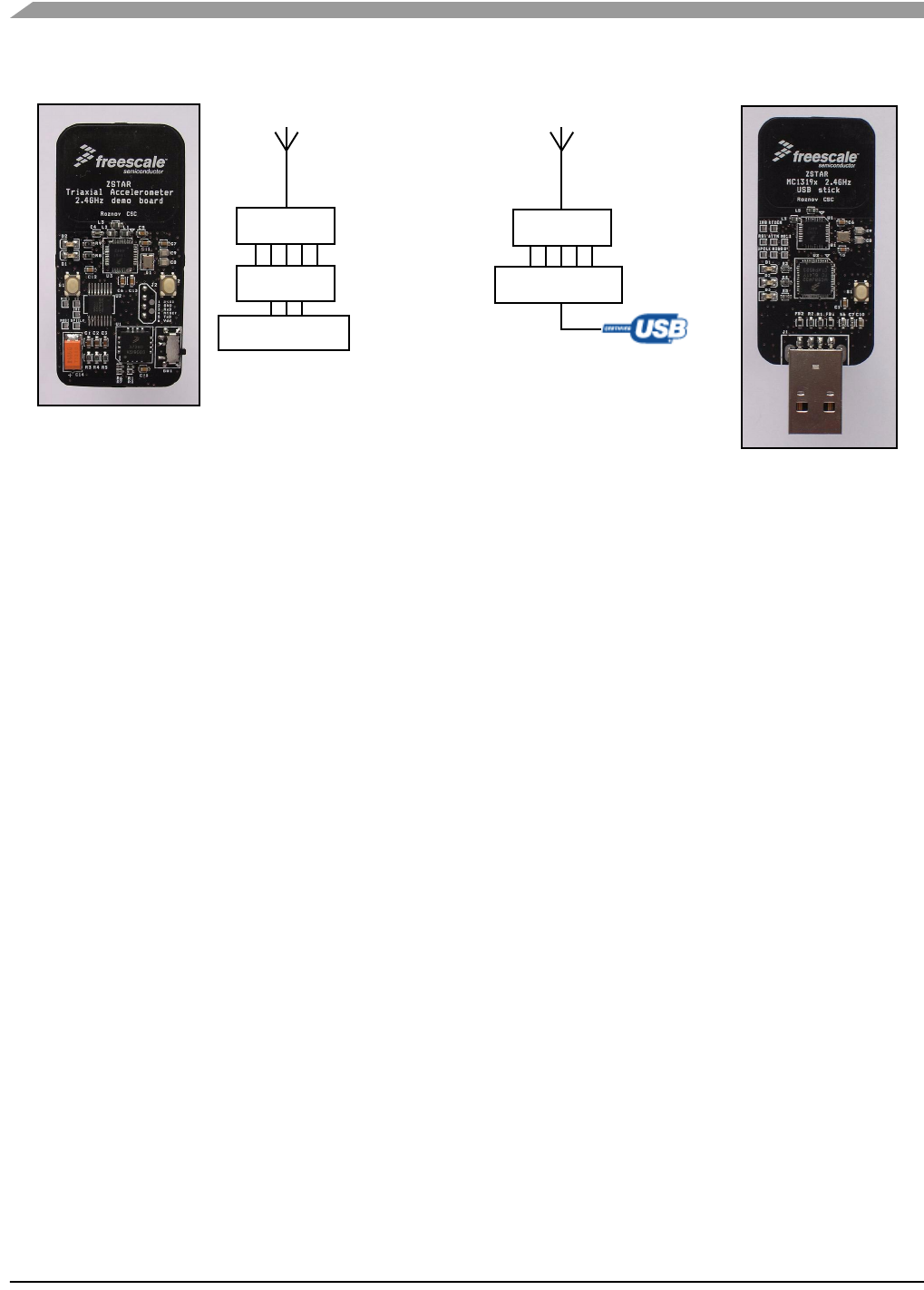
Wireless Sensing Triple Axis Reference design introduction
Wireless Sensing Triple Axis Reference design, Rev. 0.9
12 Freescale Semiconductor
Figure 2-2ZSTAR Block diagram
2.2 Featured products
This demo consist of several Freescale products whose main features are listed below.
2.2.1 Triple Axis Accelerometer MMA7260Q
The ZSTAR board is a demonstration tool for the MMA7260Q, a 3-Axis Low-g accelerometer. The
MMA7260Q has many unique features that make it an ideal solution for many consumer applications,
such as freefall protection for laptops and MP3 players, tilt detection for e-compass compensation and
mobile phone scrolling, motion detection for handheld games and game controllers, position sensing for
g-mice, shock detection for warranty monitors, and vibration for out of balance detection.
Features such as low power, low current, and a sleep mode with a quick turn on time, allow the battery
life to be extended in end applications. The 3-axis sensing in a small QFN package requires only a 6mm
x 6mm board space, with a profile of 1.45mm, allowing for easy integration into many small handheld
electronics.
There are several other derivatives of the MMA7260Q:
•MMA7261Q with a selectable 2.5g to 10g range
•MMA6270Q is an XY dual axis accelerometer
•MMA6280Q is an XZ dual axis accelerometer
All members of this sensor family are footprint (QFN package) compatible which simplifies evaluation and
design of the target application.
2.2.2 Microcontroller MC9S08QG8
The MC9S08QG8 is a highly integrated member of Freescale’s 8-bit family of microcontrollers based on
the high-performance, low-power consumption HCS08 core. Integrating features normally found in larger,
more expensive components, the MC9S08QG8 MCU includes a background debugging system and
on-chip in-circuit emulation (ICE) with real-time bus capture, providing a single-wire debugging and
S08QG8
MC13191
MMA7260Q
MC13191
HC908JW32

Featured products
Wireless Sensing Triple Axis Reference design, Rev. 0.9
Freescale Semiconductor 13
emulation interface. It also features a programmable 16-bit timer/pulse-width modulation (PWM) module
(TPM), that is one of the most flexible and cost-effective of its kind.
The compact, tightly integrated MC9S08QG8 delivers a versatile combination, from wealth of Freescale
peripherals and the advanced features of the HCS08 core, including extended battery life with a
maximum performance down to 1.8V, industry-leading Flash and innovative development support. The
MC9S08QG8 is an excellent solution for power and size-sensitive applications, such as wireless
communications and handheld devices, small appliances, Simple Media Access Controller
(SMAC)-based applications and toys.
• MC9S08QG8 Features
– Up to 20 MHz operating frequencies at >2.1 volts and 16 MHz at <2.1 volts
– 8 K Flash and 512 bytes RAM
– Support for up to 32 interrupt/reset sources
– 8-bit modulo timer module with 8-bit prescaler
– Enhanced 8-channel, 10-bit analog-to-digital converter (ADC)
– Analog comparator module
– Three communication interfaces: SCI, SPI and IIC
2.2.3 MC13191 2.4 GHz ISM Band Low Power Transceiver
The MC13191 is a short range, low power, 2.4 GHz Industrial, Scientific, and Medical (ISM) band
transceivers. The MC13191 contains a complete packet data modem which is compliant with the IEEE®
802.15.4 Standard PHY (Physical) layer. This allows the development of proprietary point-to-point and
star networks based on the 802.15.4 packet structure and modulation format. For full 802.15.4
compliance, the MC13192 and Freescale 802.15.4 MAC software are required.
When combined with an appropriate microcontroller (MCU), the MC13191 provides a cost-effective
solution for short-range data links and networks. Interface with the MCU is accomplished using a four wire
serial peripheral interface (SPI) connection and an interrupt request output, which allows the use of a
variety of processors. The software and processor can be scaled to fit applications ranging from simple
point-to-point to star networks.
2.2.4 Microcontroller MCHC908JW32
The MCHC908JW32 is a member of the low-cost, high-performance M68HC08 Family of 8-bit
microcontroller units (MCU’s). All MCU’s in the family use the enhanced M68HC08 central processor unit
(CPU08) and are available in a variety of modules, memory sizes and types, and package types.
• MCHC908JW32 Features
– Maximum internal bus frequency: 8-MHz at 3.5-5V operating voltage
– Oscillators:
- 4-MHz crystal oscillator clock input with 32MHz internal phase-lock loop
- Internal 88-kHz RC oscillator for timebase wakeup
– 32,768 bytes user program FLASH memory with security feature
– 1,024 bytes of on-chip RAM
– 29 general-purpose input/output (I/O) ports:
– 8 keyboard interrupt with internal pull-up
- 3 pins with direct LED drive
- 2 pins with 10mA current drive for PS/2 connection

Wireless Sensing Triple Axis Reference design introduction
Wireless Sensing Triple Axis Reference design, Rev. 0.9
14 Freescale Semiconductor
– 16-bit, 2-channel timer interface module (TIM) with selectable input capture, output compare,
PWM capability on each channel, and external clock input option
– Timebase module
– PS/2 clock generator module
– Serial Peripheral Interface Module (SPI)
– Universal Serial Bus (USB) 2.0 Full Speed functions:
- 12 Mbps data rate
- Endpoint 0 with an 8-byte transmit buffer and an 8-byte receive buffer
- 64 bytes endpoint buffer to share amongst endpoints 1–4
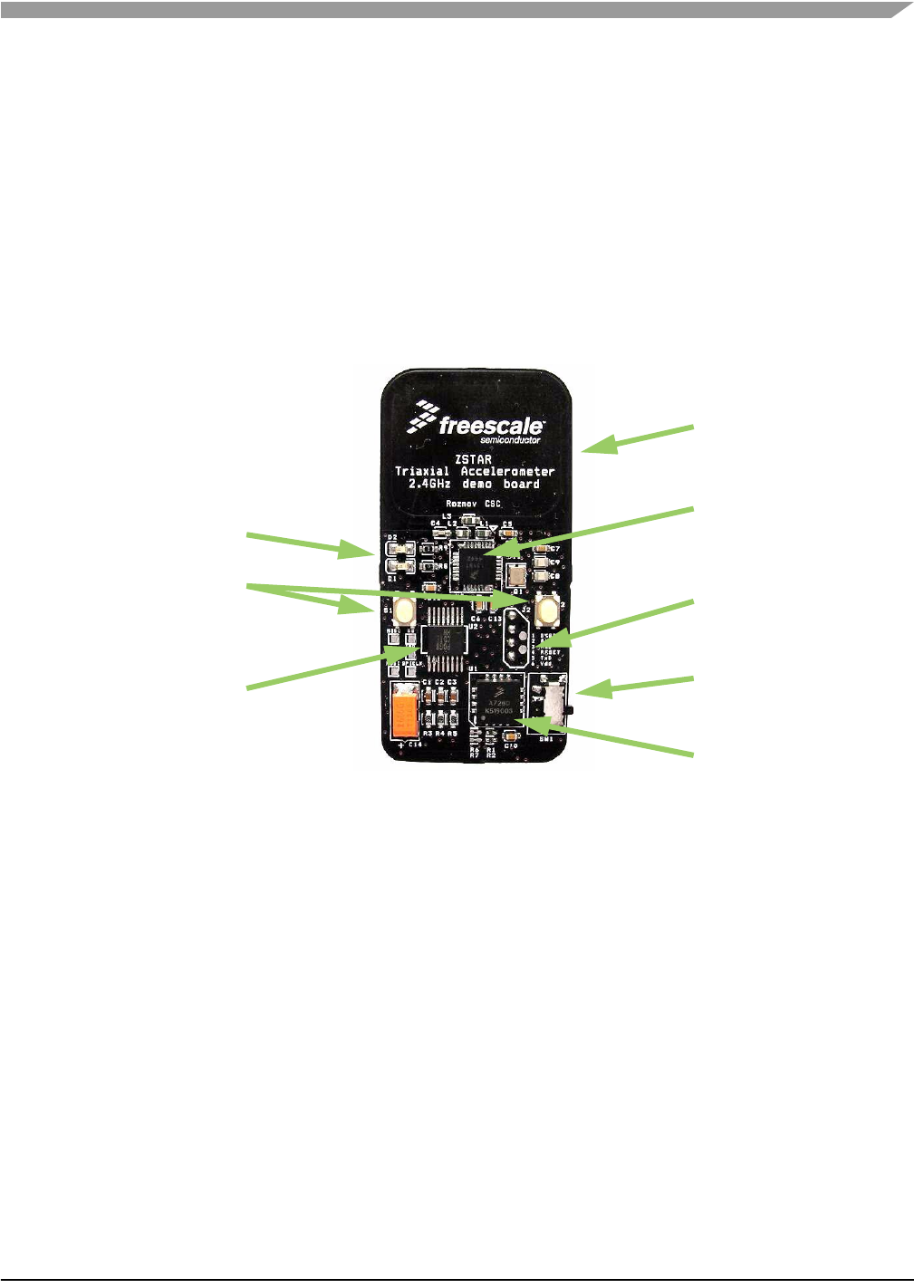
Wireless Sensing Triple Axis Reference design, Rev. 0.9
Freescale Semiconductor 15
Chapter 3 Sensor Board description
3.1 Board overview
The Sensor Board utilizes a small footprint size dual-layer printed circuit board (PCB) containing all the
necessary circuitry for MMA7260Q accelerometer sensing and transferring data over a radio frequency
(RF).
Figure 3-1Sensor Board overview
The board is powered by a Lithium coin-sized CR2032 battery with provisions also made for the larger
capacity CR2477 size. The block diagram of the board is as follows:
Lithium battery on the opposite side
MC13191
MC9S08QG8
MMA7260Q
Battery Switch
LED indicators
PCB antennas
BDM interface
Buttons

Sensor Board description
Wireless Sensing Triple Axis Reference design, Rev. 0.9
16 Freescale Semiconductor
Figure 3-2Sensor board block diagram
Figure 3-3 shows in more detail, how different software and hardware modules co-operate with each
other. The main task of the Sensor board is to:
• periodically wake-up from power saving mode
• measure all three XYZ acceleration values from the sensor
• compose a data frame using simple ZSTAR RF protocol
•use SMAC (Simple Media Access Controller) to send this data frame over the RF link
• wait for an acknowledgment from the other end (here, the USB stick)
• go to sleep
This basic loop repeats roughly 20 times per second providing nearly a real-time response from the
sensor.
MMA7260Q
accelerometer
X Y Z sleep g-select
MC9S08QG8
MCU
MC13191
2.4GHz RF
receive antenna
transmit antenna
SPI
IRQ
CR2032 or CR2477
Lithium battery
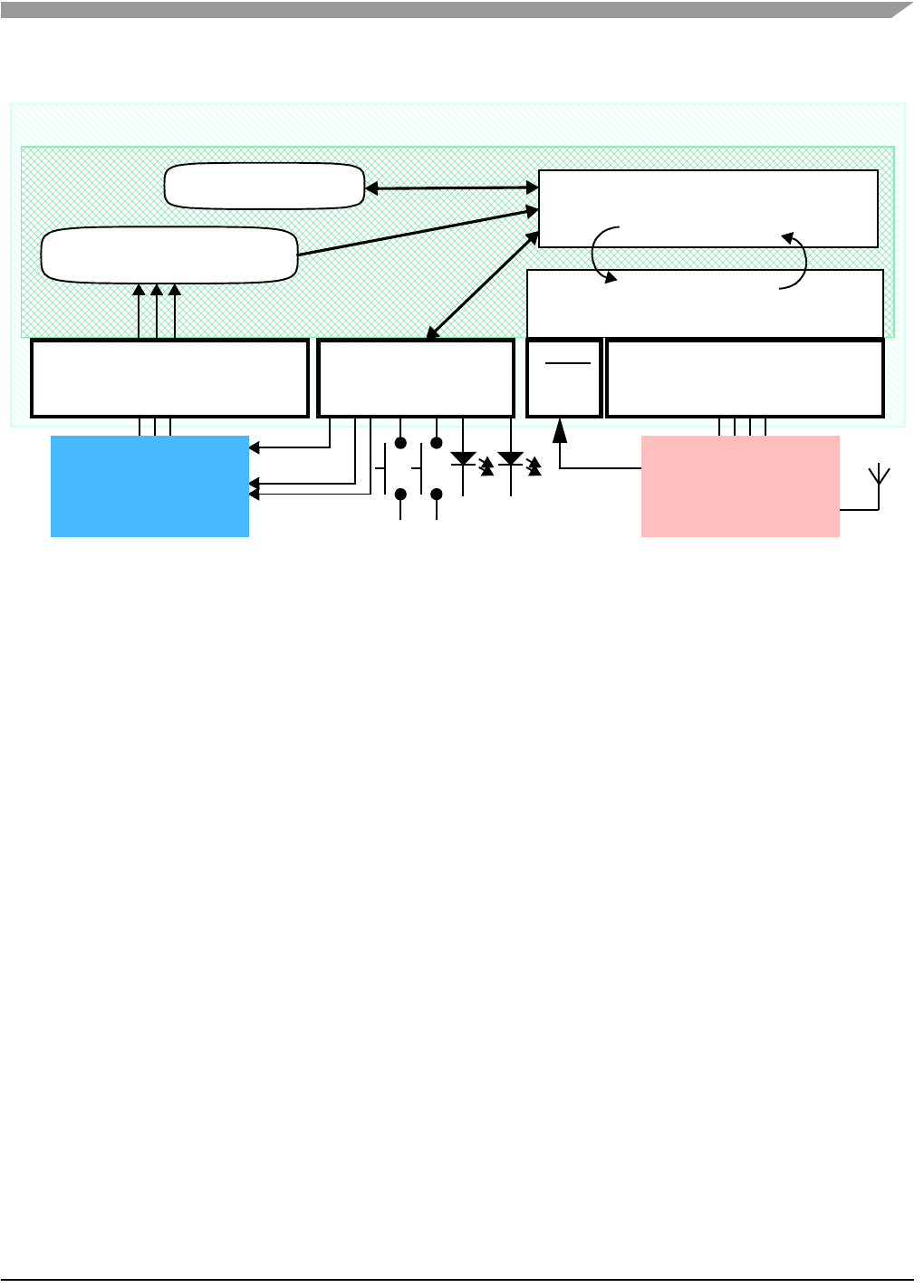
A/D conversion of XYZ levels
Wireless Sensing Triple Axis Reference design, Rev. 0.9
Freescale Semiconductor 17
Figure 3-3ZSTAR Sensor board software overview
For the Sensor board operation, several of the MC9S08QG8’s hardware modules are used: Analog to
Digital Converter (ADC), Synchronous Peripheral Interface (SPI), External Interrupt Request module
(IRQ) and General Purpose Input/Output (GPIO).
3.2 A/D conversion of XYZ levels
The 3-axis accelerometer sensor MMA7260Q provides three separate analog levels for the X, Y and Z
axis. These outputs are ratiometric which means that the output offset voltage and sensitivity will scale
linearly with applied supply voltage. This is a key feature when interfacing to a microcontroller with A/D
converter reference levels tied to a power supply, because it provides system level cancellation of supply
induced errors in the analog to digital conversion process.
During the analog-to-digital conversion in the microcontroller, 8-bit resolution is used. MC9S08QG8 A/D
channels 0, 1 and 2 are connected to X (channel 1), Y (channel 2) and Z (channel 0) outputs of the
MMA7260Q. The microcontroller’s APCTL1 register enables these ADC channels for pin I/O control by
the ADC module.
The ADCCFG register controls the selected mode of operation, clock source, clock divide, and
configuration for low power or long sample time.
3.2.1 ADC module init:
APCTL1 = 0b00000111; /* 0,1,2 channels are ADC */
ADCCFG = 0b01100000; /* set prescale to 8, ADICLK=BUS, 8-bit, high speed */
Actual ADC measurements are done in the main software loop. There is a macro (called POWSUM) that
allows configuration of measurement to take several measurements of each channel during one loop. E.g.
changing POWSUM to 3, 2^3 = 8, each channel will be measured 8 times, with POWSUM 7, each channel
Sensor data
Analog-to-Digital converter
(ADC) module
MC9S08QG8
SMAC
ZSTAR RF protocol handler
sleep
software
calibration data
g-select
Serial Peripheral Interface
(SPI) module
IRQ
MC13191
MMA7260Q
GPIO

Sensor Board description
Wireless Sensing Triple Axis Reference design, Rev. 0.9
18 Freescale Semiconductor
is measured 128 times. By default, POWSUM is 0, for 1 measurement of each channel. Before result values
are provided, the accumulated values are scaled back to the 8-bit range and inverted where necessary
(may be required depending on the physical MMA7260Q device orientation relative to the Earth gravity).
Raw (i.e. not calibrated) values are actually sent, the calibration and calculation of an exact g value is
done internally in the PC software.
3.2.2 ADC measurement
The following routine is used for accelerometer measurement:
unsigned int xx = 0;
unsigned int yy = 0;
unsigned int zz = 0;
unsigned char xxx, yyy, zzz;
#define POWSUM 0
for (i = 0; i < (1 << POWSUM); i++)
{
ADCSC1 = 0x01; //read X channel
while(!ADCSC1_COCO);
xx += ADCR;
ADCSC1 = 0x02; //read Y channel
while(!ADCSC1_COCO);
yy += ADCR;
ADCSC1 = 0x00; //read Z channel
while(!ADCSC1_COCO);
zz += ADCR;
}
xxx = ~(unsigned char)(xx >> POWSUM);
yyy = ~(unsigned char)(yy >> POWSUM);
zzz = (unsigned char)(zz >> POWSUM);
3.3 Power management
A CR2032 (or CR2477) Lithium battery provides a fairly limited charge for such a realtime-like demo that
demands frequent transmissions. Some sort of power management has to be implemented in order to
keep the current consumption at a reasonable level.
Typically, current consumptions of Sensor board components are as follows:
• 2.4GHz transceiver MC13191
– in Hibernate mode, 2.3µA
– in Doze mode, 35µA
– in Idle mode, 500µA
– in Transmit mode, 30mA
– in Receive mode, 37mA
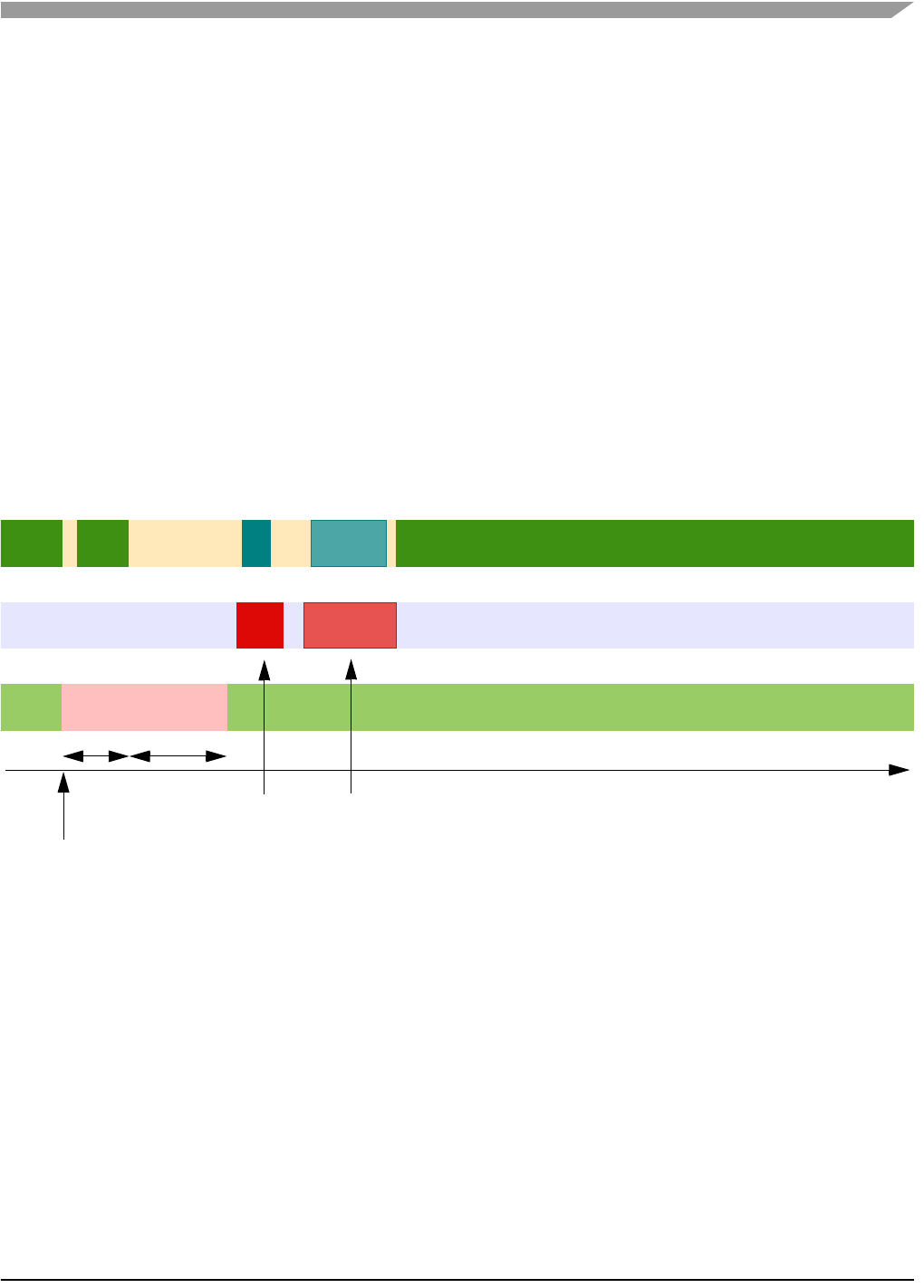
Power management
Wireless Sensing Triple Axis Reference design, Rev. 0.9
Freescale Semiconductor 19
• 8-bit microcontroller MC9S08QG8
– in Stop mode, 750nA
– in Wait mode, 1mA
– in Run mode, 3.5mA
• low-g triaxial sensor MMA7260Q
– in Sleep mode, 3µA
– in Normal mode, 500µA
It is obvious that in a battery operated application care must be taken to ensure the lowest possible current
consumption, especially when the maximum current (provided by the battery) is somehow limited. A
CR2032 Lithium battery cannot provide current in the range of 40mA for long periods of time. To alleviate
high current surges, an additional large capacitor has been designed - see 3.4.10 Power supply.
For transmission and reception using the MC13191, a specific scheme has been used to ensure the
battery is not depleted or overloaded. Targeting a 20 samples per second (50ms period) transmission
rate, the following scheme for one transmission/sleep cycle is used for the data transfer:
Figure 3-4Transmission/sleep cycle details
As shown on the previous diagram, all parts of the Sensor board remain most of the time in
Sleep/Doze/Stop modes, in which the total current consumption is below 10µA.
During each loop, once the data has been acquired from sensor, transmission over the MC13191
transceiver is initiated. The current consumption of the transmitter is ~30mA at that time, but only for a
short period of time (typically ~600µs).
In order to keep the sensor board informed on the status of connection (for example, if the data-receiving
side - USB stick - is out of range, disconnected, etc.), the reception has to be turned on after the data has
been transmitted. This is not really required within each loop cycle, and in the actual implementation only
on every 8th loop the receive window opens (receiver is enabled to receive the acknowledgment). More
in the 5.3 ZSTAR RF protocol description.
time
Sleep
wake-up
Normal
MMA7260Q:
Doze
MC13191:
Stop
MC9S08QG8:
Stop
Sleep
Run Stop
Sensor
stabilizes Sensor
being
measured
TX
Wait
Wait
RX
optional
receive
window NOT TO SCALE
Doze
data
transmitted

Sensor Board description
Wireless Sensing Triple Axis Reference design, Rev. 0.9
20 Freescale Semiconductor
The reception window is larger to fit any incoming receive data and the current consumption is also higher
during reception, so this portion of current consumption would be one of the largest if the acknowledgment
was received in every loop cycle.
The “optional receive” feature allows huge power savings, still keeping the reception of acknowledgment
data from the data-receiving side.
Some further savings might be incorporated by utilizing the timer-triggered transceiver events that are
described in the MC13191 Reference Manual.The MC13191, for example, latches a so-called time-stamp
of each received frame. The data-receiving side may read this value and trigger the acknowledgment to
be sent at exactly specified time after reception (also, a start of data frame transmission can be
programmed as timer-triggered). The sensor board might then narrow its own receive window to perfectly
match the expected time of the acknowledgment frame. For the simplicity of code, this has not been
implemented in the current version of ZSTAR firmware.
3.3.1 MC13191 power management features
MC13191 provides several power saving modes. One of them is called Doze mode in which the
MC13191 crystal oscillator remains active. An internal timer comparator is functional too, providing a
power efficient and accurately timed way of waking-up the application after a specified time.
This feature is fully utilized within the Sensor board. The microcontroller calculates the time period for
which the application should be in power saving mode, then fills in the timer comparator registers in the
MC13191, and the microcontroller goes into Stop mode (MC13191 into Doze mode).
Once the timer reaches the pre-programmed time (a timer compare occurs), the MC13191’s IRQ signal
is asserted which brings the microcontroller out of the Stop mode. There are various scaling possibilities
that allow periods from a few µs up to 1073 seconds (~17 minutes) to be programmed, without
intervention of the microcontroller.
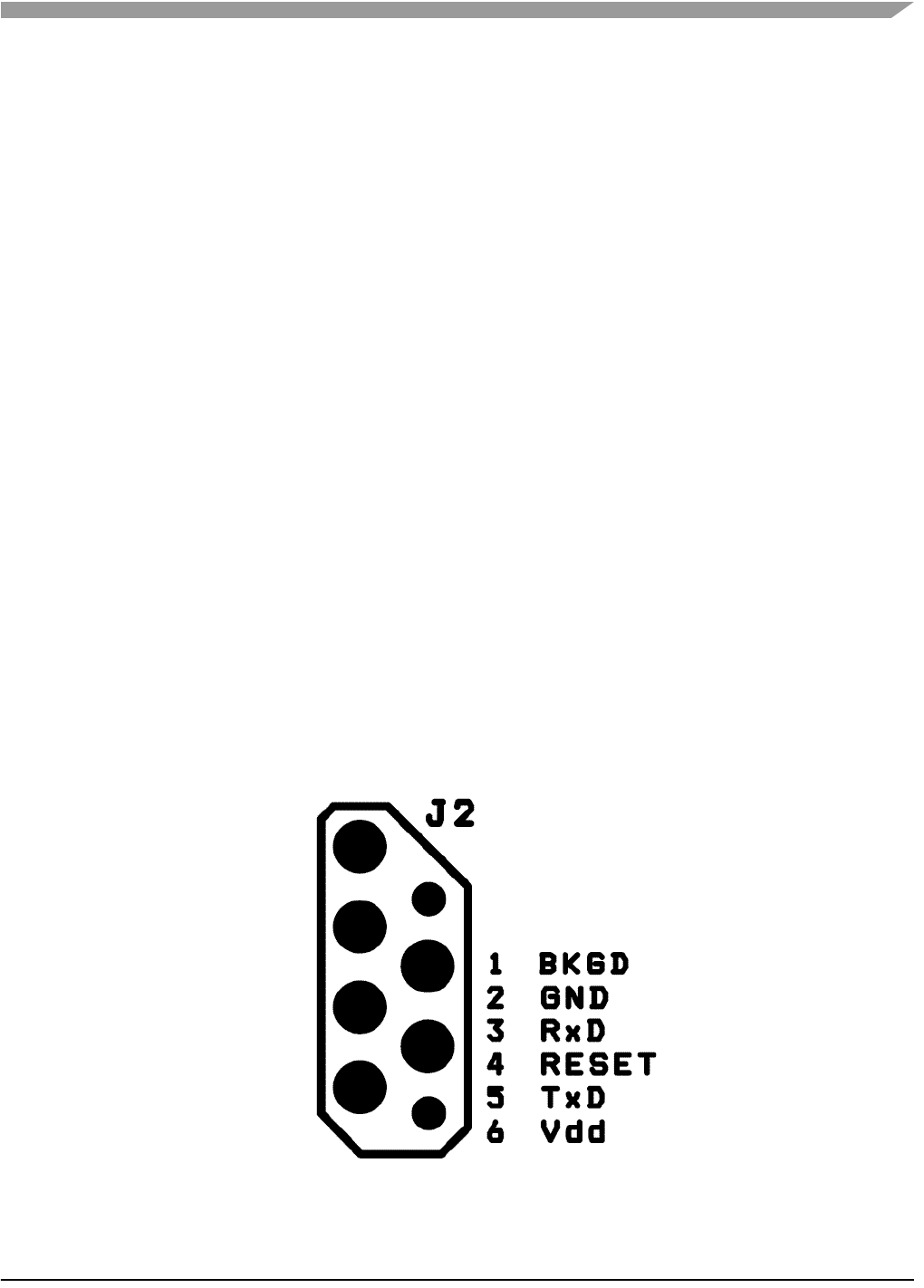
ZSTAR Sensor Board hardware overview
Wireless Sensing Triple Axis Reference design, Rev. 0.9
Freescale Semiconductor 21
3.4 ZSTAR Sensor Board hardware overview
This section describes the Sensor board in terms of the hardware design. The MC9S08QG8
microcontroller drives both the MMA7260Q sensor and the MC13191 RF transceiver.
3.4.1 Analog connections
The MMA7260Q sensor is connected to AD0, AD1, and AD2 inputs to analog-to-digital converter via RC
filters formed by R3, C3, R4, C2, R5, C1. These are recommended to minimize clock noise from the
switched capacitor filter circuit inside the sensor. Once the software filtering (also described in 3.2 A/D
conversion of XYZ levels) is employed, these RC filters may be completely omitted.
3.4.2 g-select connections
R1, R2, R6 and R7 components are made on the PCB. R1 and R2 are just footprints with no components
assembled, while R6 and R7 are connected with copper trace allowing the user to disconnect (cut) these
lines. By default, g-sel1 and g-sel2 MMA7260Q sensor input pins (used to select the acceleration range)
are connected to pins PTB0 and PTB1 of the microcontroller. The range can be controlled by software.
If user does not want to use this feature, the g-range can be selected by placing 0R resistors in the R1
and/or R2 positions. If no resistors are assembled, MMA7260Q internal pull-down resistors will
automatically select the 1.5g range (both g-sel inputs low).
Once R6 and R7 are cut, PTB0 and PTB1 (or their alternate SCI functionality of RxD1 and TxD1, or KBI
or AD inputs) may be used. These signals are also routed to BDM connector, pins 3 and 5.
3.4.3 BDM (Background Debug Mode) connections
A J2 connector is a non-standard footprint primarily intended for in-factory programming and testing via
“spring-needle” type of connections. The J2 connector carries all standard signals for Background Debug
Mode communication so if required, one may solder wires and a standard 2x3 pins 2.54mm (100mil) pitch
header for regular BDM re-programming. The pin numbering is shown on Figure 3-5.
Figure 3-5BDM connector layout
1
23
45
6
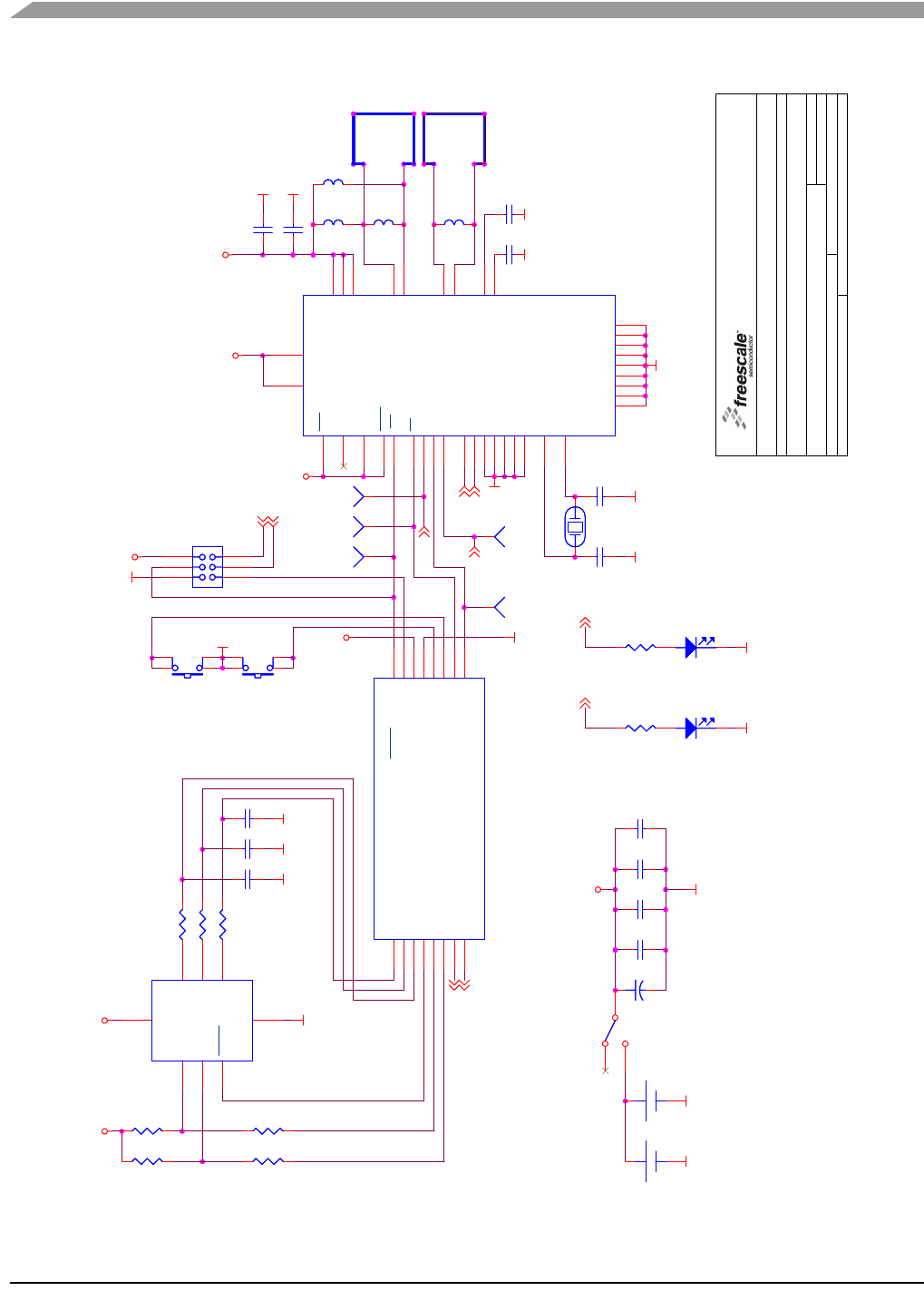
Wireless Sensing Triple Axis Reference design, Rev. 0.9
22 Freescale Semiconductor
Sensor Board description
3.4.4 Sensor Board schematics
Figure 3-6Sensor board schematics
G_SEL2/TxD
G_SEL1/RxD
VDD
VDD
VDD
VDD
VDD
VDDA
GND GND
GND
GND GND
GND
GND
GND
GND
GND GND GND GND
GND
GNDGND
VDD
VDD
GND GND
GND
GND
MOSI
SPICLK
MOSI
G_SEL1/RxD
G_SEL2/TxD
LED1
LED2
LED1 LED2
SPICLK
Title
Size
Design Name:
Rev
Modify Date: Sheet of
Schematic Name:
Copyright Freescale
POPI Status:
Author:
1.0
Low-cost 2.4GHz Triax Board
Freescale Semiconductor RCSC
1. maje 1009
756 61 Roznov p.R., Czech Republic, Europe
A4
11
Monday, January 30, 2006
SCHEMATIC1
General Business Information
Radomir Kozub & Pavel Lajsner
2005
X:\ICONN\IC108 - LOW-COST 2.4GHZ AND XYZ ACCELEROMETER DEMO\HW\00239\00239.DSN
Title
Size
Design Name:
Rev
Modify Date: Sheet of
Schematic Name:
Copyright Freescale
POPI Status:
Author:
1.0
Low-cost 2.4GHz Triax Board
Freescale Semiconductor RCSC
1. maje 1009
756 61 Roznov p.R., Czech Republic, Europe
A4
11
Monday, January 30, 2006
SCHEMATIC1
General Business Information
Radomir Kozub & Pavel Lajsner
2005
X:\ICONN\IC108 - LOW-COST 2.4GHZ AND XYZ ACCELEROMETER DEMO\HW\00239\00239.DSN
Title
Size
Design Name:
Rev
Modify Date: Sheet of
Schematic Name:
Copyright Freescale
POPI Status:
Author:
1.0
Low-cost 2.4GHz Triax Board
Freescale Semiconductor RCSC
1. maje 1009
756 61 Roznov p.R., Czech Republic, Europe
A4
11
Monday, January 30, 2006
SCHEMATIC1
General Business Information
Radomir Kozub & Pavel Lajsner
2005
X:\ICONN\IC108 - LOW-COST 2.4GHZ AND XYZ ACCELEROMETER DEMO\HW\00239\00239.DSN
12
Q1
16MHz NX2520SA
Q1
16MHz NX2520SA
R2
INF
R2
INF
1
SSSS
R3 10kR3 10k
C11
10nF
C11
10nF
C12
10nF
C12
10nF
R1
INF
R1
INF
R5 10kR5 10k
BATT1
Battery/Renata CR2032
BATT1
Battery/Renata CR2032
1 2
3 4
65
J2
BDM
J2
BDM
RFIN- 1
RFIN+ 2
PAO+ 5
PAO- 6
GPIO4
8GPIO3
9GPIO2
10 GPIO1
11
RST
12
RXTXEN
13
ATTN
14
CLKO
15
SPICLK
16
MOSI
17
MISO
18
CE
19
IRQ
20
VDDD 21
VDDINT 22
GPIO5
23
GPIO6
24
GPIO7
25
CRYSTAL1
26
CRYSTAL2
27
VDDLO2 28
VDDLO1 29
VDDVCO 30
VBATT 31
VDDA 32
EPGND
36 EPGND
37 EPGND
38 EPGND
39 EPGND
40 EPGND
41
EPGND
35
EPGND
34
EPGND
33
U3 MC13191FCU3 MC13191FC
C6
10nF
C6
10nF
C7
10nF
C7
10nF
D2
LED
D2
LED
L2
22nH
L2
22nH
1
SPICLKSPICLK
g-Sel1
1
g-Sel2
2
VDD 3
VSS
4
SLEEP
12 Z13
Y14
X15
U1 MMA7260Q
U1 MMA7260Q
L3
5.6nH
L3
5.6nH
C1
100nF
C1
100nF
C5 10nFC5 10nF
L1
22nH
L1
22nH
D1
LED
D1
LED
BATT2
Battery/Renata CR2477
BATT2
Battery/Renata CR2477
1
IRQIRQ
1 3
42
S1
Alps SKRP
S1
Alps SKRP
L4
4.7nH
L4
4.7nH
1
MOSIMOSI
R7
0R
R7
0R
1
MISOMISO
+
C14
470uF/4V
+
C14
470uF/4V
R9
0R
R9
0R
C13
10nF
C13
10nF
R6
0R
R6
0R
C9
6.8pF
C9
6.8pF
C3
100nF
C3
100nF
13
4 2
S2
Alps SKRP
S2
Alps SKRP
R8
0R
R8
0R
PTB4/MISO1 8
PTB3/KBI7/AD7/MOSI1
9
PTA4/BKGD/MS/ACMP1O 2
Vdd 3
PTA0/KBI0/AD0/TPM1CH0/ACMP1+
16
PTA1/KBI1/AD1/ACMP1-
15
PTA2/KBI2/AD2/SDA1
14
PTA5/RESET/IRQ/TCLK 1
Vss 4
PTB7/SCL1/EXTAL 5
PTB6/SDA1/XTAL 6
PTB5/TPM1CH1/SS1 7
PTB1/KBI5/AD5/TxD1
11 PTB0/KBI4/AD4/RxD1
12 PTA3/KBI3/AD3/SCL1
13
PTB2/KBI6/AD6/SPSCK1
10
U2
MC9S08QG8CDTE
U2
MC9S08QG8CDTE
C8
6.8pF
C8
6.8pF
C2
100nF
C2
100nF
C10
10nF
C10
10nF
SW1
Alps/SSSS811101
SW1
Alps/SSSS811101
R4 10kR4 10k
C4 100pFC4 100pF

ZSTAR Sensor Board hardware overview
Wireless Sensing Triple Axis Reference design, Rev. 0.9
Freescale Semiconductor 23
3.4.5 Button connections
Two buttons (S1 and S2) are connected directly to pins PTB6 and PTB7. Both have internal pull-up
resistors, but are not part of the Keyboard interrupt module, therefore don’t allow a direct microcontroller
wake-up from the Stop modes.
3.4.6 MC13191 to MC9S08QG8 microcontroller interface
In order to fit all the necessary circuitry onto a 16-pin microcontroller, the full recommended MC13191
interface has had to be reduced. The full interface includes the following connections:
• 4-wire Synchronous Peripheral Interface (SPI) connection (MISO, MOSI, SPICLK, CE)
• Interrupt Request signal (IRQ)
• Attention (ATTN) wake-up signal
• Receive/Transmit Enable (RXTXEN) signal
• External Reset (RST) signal
SPI and IRQ are vital for the communication and configuration ofthe MC13191. SPI is connected to the
MC9S08QG8 SPI module (pins PTB4/MISO1, PTB3/MOSI1, PTB2/SPSCK1, and GPIO pin PTB5 for
CE).
Interrupt Request (IRQ) is connected to the microcontroller IRQ pin sharing its alternate RESET function
when BDM communication is active.
Attention (ATTN) signal is intended to externally wake-up the MC13191 from Doze and Hibernate
modes. Since this feature is not used and exit from the Doze mode is done using a timer compare event,
The ATTN pin is not routed to the microcontroller and needs to be connected to Vdd.
Receive/Transmit Enable (RXTXEN) signal is used to control transitions to/from receive and transmit
modes. Since this can be accomplished just by software programming and/or timer compare events, this
connection to the microcontroller may also be omitted, saving an additional pin. RXTXEN is connected to
Vdd.
External Reset (RST) signal places the transceiver in a complete reset condition (Off mode and power
down). Alternative Software reset is also possible and since Off mode (the one with the lowest possible
power consumption) is not required too, RST is connected to Vdd too.
3.4.7 MC13191 RF interface
The RF interface (antennas) were designed with the cost and board size in mind. Among several designs,
the PCB layout antennas were in the main consideration (cost). Of several PCB antenna designs
available for the 2.4GHz band (F-antenna, dipole, loop), the loop antenna has been selected mainly
because of the size required on the PCB.
The MC13191 transceiver is designed with separated RF IN (receive) and PA OUT (transmit) paths. To
avoid the need for an antenna switch, two separate antennas need to be used. Both ZSTAR boards (USB
stick and Sensor Board) use the same antenna layout, there are two antennas on the PCB, just on the
opposite sides of the PCB.
The antenna is designed as a rectangle, 20x24mm (780x940mils), made of 1.25mm (50mils) wide trace
of copper. The corners are rounded with a 3.8mm (150mils) radius.
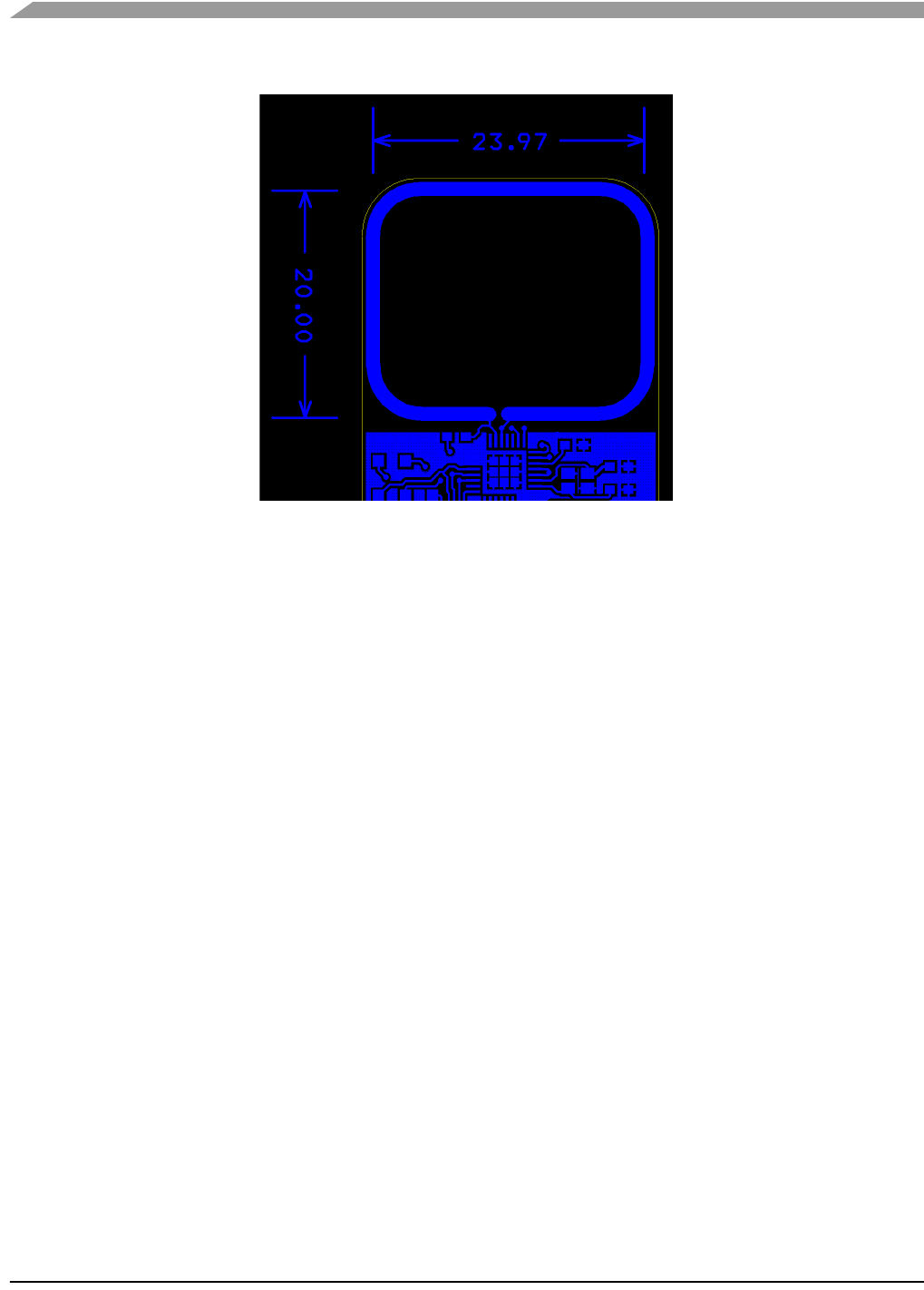
Sensor Board description
Wireless Sensing Triple Axis Reference design, Rev. 0.9
24 Freescale Semiconductor
Figure 3-7ZSTAR antenna layout
The matching is provided by L3 (transmit antenna) and L4 (receive antenna) coils. L1 and L2 coils bias
the transmitter output transistors to the VDDA level.
The inductors used in this design are from TDK:
L3 (5.6nH) MLG1608B5N6DT
L4 (4.7nH) MLG1608B4N7ST
and L1, L2 (22nH) MLG1608B22NJT.
3.4.8 Clocking options of MC9S08QG8
Due to the availability of accurate timing provided by the MC13191 transceiver, an internal oscillator (ICG)
in the MC9S08QG8 is used as the main clock source for the microcontroller. The protocol related timing
is derived from MC13191 timers, the microcontroller itself is clocked from an internal oscillator, leaving
the oscillator pins as GPIO. This is highly beneficial to the limited pin count microcontroller.
3.4.9 LED indicators connections
The MC13191 allows extension to the number of general I/O pins by 7 additional GPIO connections. Two
of these (GPIO1 and GPIO2) are used for LED indicators. R8 and R9 are their current limiting resistors,
and in the actual design orange LED’s are used, with a threshold voltage around 2.0-2.5V.
The remaining unused GPIO3-GPIO7 signals are connected to ground, improving the physical PCB
layout of the MC13191.

ZSTAR Sensor Board hardware overview
Wireless Sensing Triple Axis Reference design, Rev. 0.9
Freescale Semiconductor 25
3.4.10 Power supply
The Sensor board is powered by a Lithium coin-sized battery. The primary choice was the popular
CR2032, with a PCB layout provision made for the CR2477 size. This bigger battery holds roughly 4 times
more charge (~1000mAh), but it is not as popular as CR2032 size.
A surface mounted SMTU series battery holder from RenataTM is placed on the underside of the PCB.
The SMTU series holders provide (by mechanical construction) battery reverse protection, so no
additional circuitry is required. Slide switch SW1 disconnects the battery from the application when not in
use.
A large tantalum capacitor (C14, 470µF/4V) improves the response of the power supply to current peaks
caused by reception or transmission. Coin-sized Lithium CR2032 batteries are targetted at a maximum
continuous discharge current in the range of 3mA. Such a large capacitor helps to supply enough current
to the MC13191 during a receive/transmit without significant Vdd voltage drops.

Sensor Board description
Wireless Sensing Triple Axis Reference design, Rev. 0.9
26 Freescale Semiconductor
3.5 Bill of Materials
Table 3-1. Sensor board bill of materials
Item Quantity Reference Part Manufacturer Manufacturer order code
11 BATT1 battery holder
CR2032 Renata SMTU 2032-1
2 3 C1,C2,C3 100nF TDK C1608JB1H104K
3 1 C4 100pF TDK C1608CH1H101J
47 C5,C6,C7,C10,
C11,C12,C13 10nF TDK C1608CH1E103J
5 2 C8,C9 6.8pF TDK C1608CH1H070D
6 1 L3 5.6nH TDK MLG1608B5N6DT
7 1 L4 4.7nH TDK MLG1608B4N7ST
82 D1,D2 Kingbright
KP-1608SEC Kingbright KP-1608SEC
9 1 J2 BDM + serial N/A
10 2 L1,L2 22nH TDK MLG1608B22NJT
11 1 Q1 16MHz NX2520SA NDK NX2520SA 16MHz EXS00A-02940
Specification n° EXS10B-07228
12 2 R1,R2 N/A N/A
13 3 R3,R4,R5 10k resistor 0603
package
14 2 R6,R7 N/A N/A
15 2 R8,R9 0R resistor 0603
package
16 1 SW1 slide switch
Alps/SSSS811101 Alps SSSS811101
(or SKRPACE010 or SKRPABE010)
17 2 S1,S2 switch SKRP Alps SKRPADE010
(or SKRPACE010 or SKRPABE010)
18 1 U1 MMA7260Q Freescale MMA7260Q
(MMA7260QR2 for tape and reel)
19 1 U2 MC9S08QG8CDTE Freescale MC9S08QG8CDTE
20 1 U3 MC13191FC Freescale MC13191FC
(MC13191FCR2 for tape and reel)
21 1 C14 470uF/4V Vishay 594D477X9004C2T
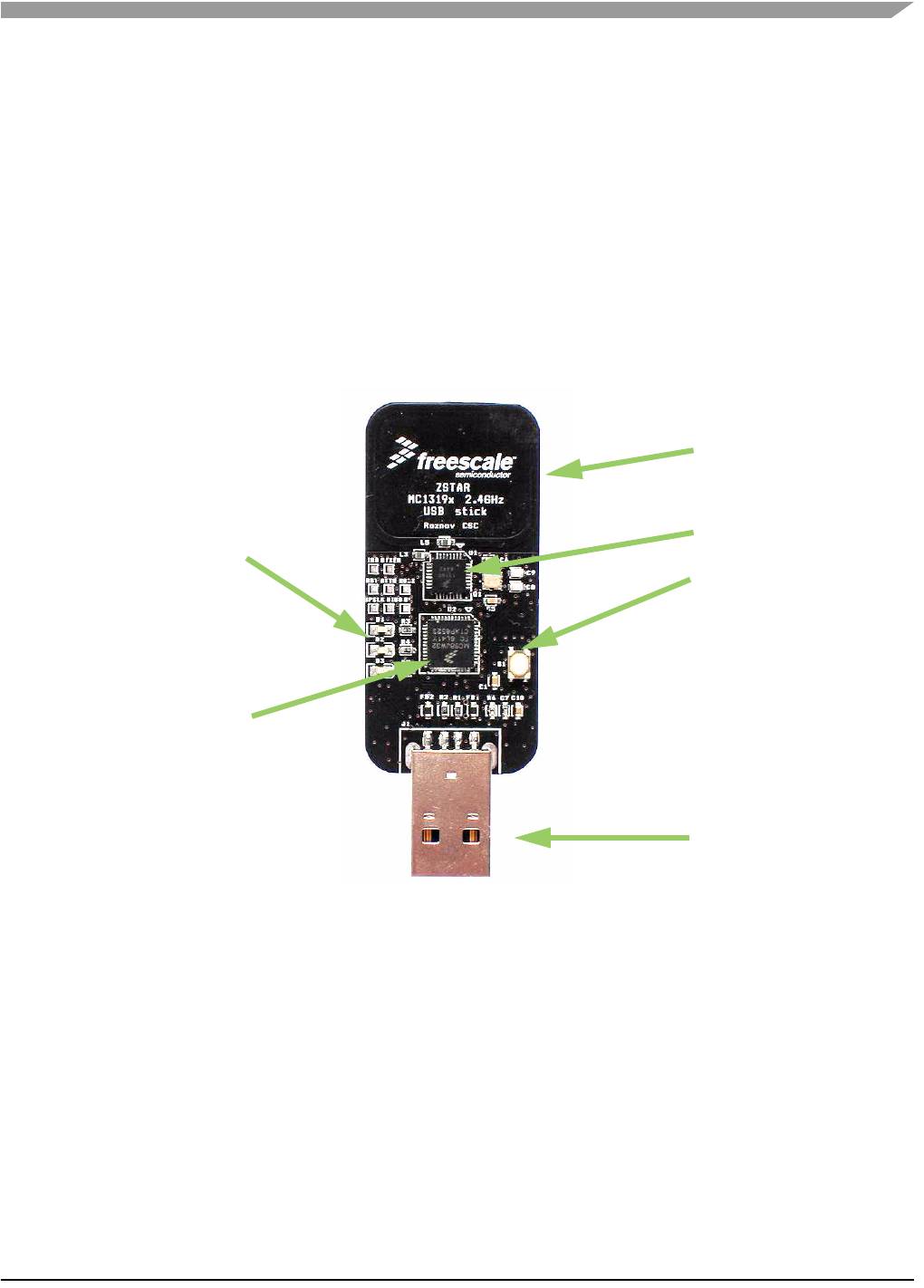
Wireless Sensing Triple Axis Reference design, Rev. 0.9
Freescale Semiconductor 27
Chapter 4 USB stick board description
4.1 Board overview
The USB stick board utilizes the same small footprint as Sensor Board is also a dual-layer printed circuit
board (PCB). It contains the minimalistic design of the MC13191 RF transceiver connected through an
8-bit MCHC908JW32 microcontroller to the USB. It’s main task is to receive data from the Sensor Board
and transfer it to the PC over the USB link.
Figure 4-1USB stick board overview
The USB stick board is powered from the USB. The block diagram of the board is as follows:
MC13191
MCHC908JW32
LED indicators
PCB antennas
USB “A” type plug
Button
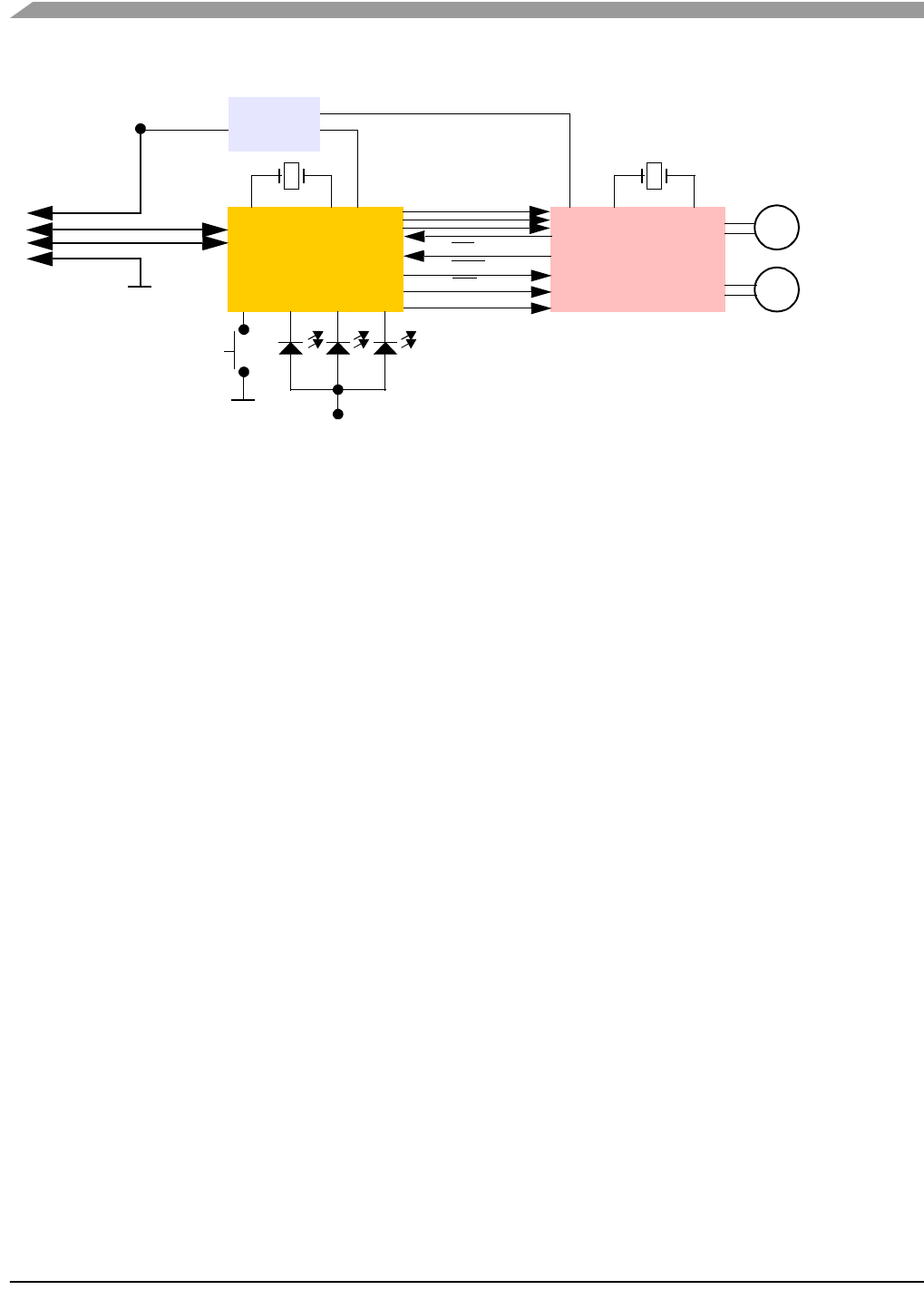
USB stick board description
Wireless Sensing Triple Axis Reference design, Rev. 0.9
28 Freescale Semiconductor
Figure 4-2USB stick board block diagram
Figure 4-3 shows, in more detail, how different software and hardware modules co-operate with each
other. There are two main tasks of the USB stick board:
• receive the data from the MC13191 transceiver and store it in RAM buffer
• handle the USB module communication, decode and provide the data from the RAM buffer
These two are somewhat independent and the only common point between them is the accelerometer
and button data buffer in RAM. The RF software communicates with the Sensor Board and retrieves the
latest accelerometer data. This is stored in RAM and can be independently read by the PC application via
the USB link. The protocol employed on the PC side is just a subset of the simple STAR protocol used in
the original RD3112MMA7260Q demo. The protocol is described in chapter 5.4 STAR protocol and
ZSTAR extensions (over USB).
MCHC908JW32
MCU
MC13191
2.4GHz RF
receive antenna
transmit antenna
SPI
IRQ
ATTN
RST
RXTXEN
USB
+5V USB voltage
regulators
+5V USB
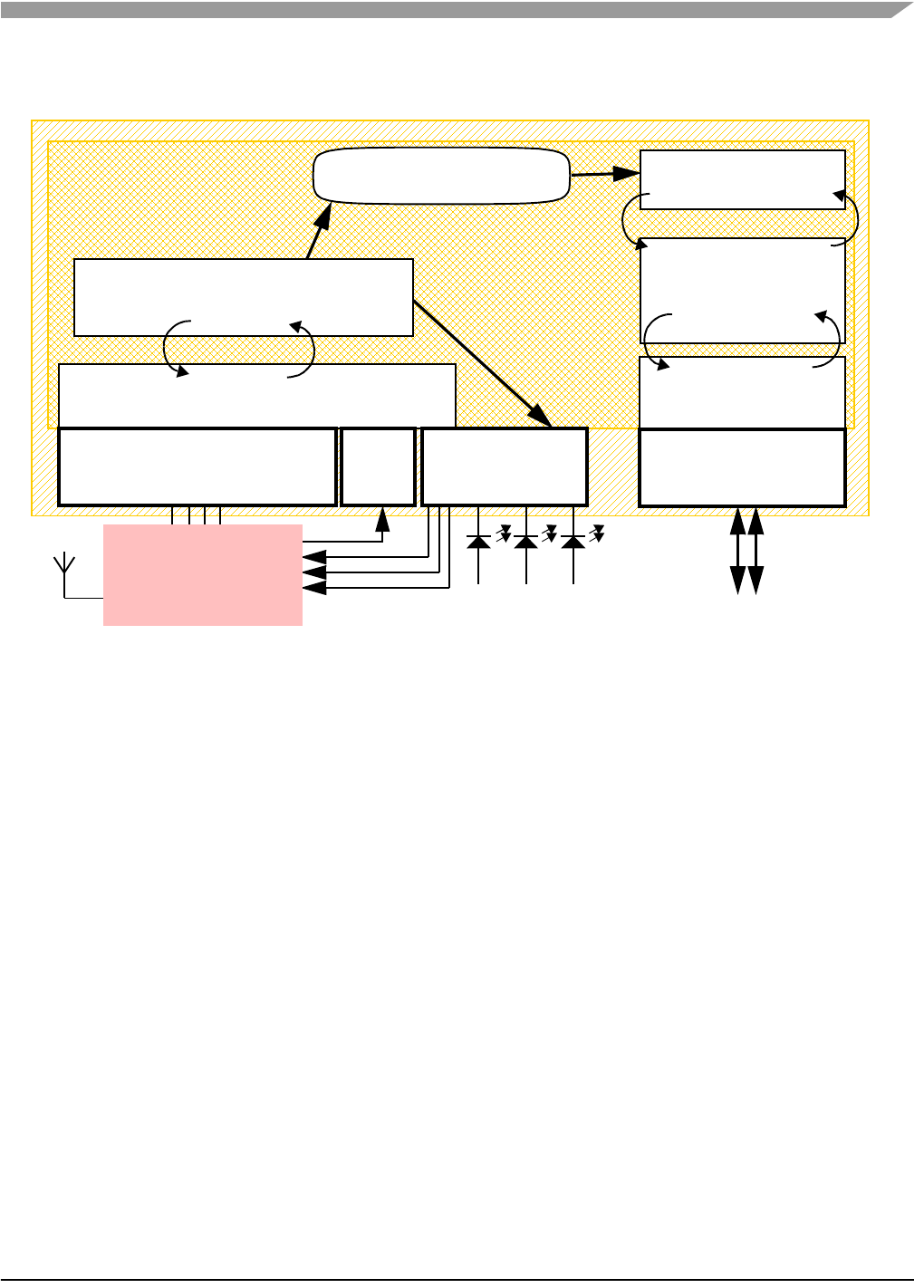
Board overview
Wireless Sensing Triple Axis Reference design, Rev. 0.9
Freescale Semiconductor 29
Figure 4-3ZSTAR USB stick board software overview
For the USB stick board operation, several MCHC908JW32 hardware modules are used: USB 2.0
Full-speed module (USB), Synchronous Peripheral Interface (SPI), Keyboard Interrupt module (KBI) and
a General Purpose Input/Output (GPIO).
SMAC
low-level USB
Sensor & Button data
USB connection to PC
USB protocol
ZSTAR RF protocol handler
MCHC908JW32
USB 2.0
“virtual serial port”
software
Serial Peripheral Interface
(SPI) module KBI GPIO Full Speed module
MC13191
protocol driver
or mouse
handler
simple STAR
protocol handler

USB stick board description
Wireless Sensing Triple Axis Reference design, Rev. 0.9
30 Freescale Semiconductor
4.2 ZSTAR USB stick Board hardware overview
This section describes the USB stick board in terms of the hardware design. The MCHC908JW32
microcontroller drives the MC13191 RF transceiver and communicates over USB with PC.
4.2.1 USB connections
Two USB communication lines are connected directly via R1 to PTE2/D+ and R2 to PTE3/D-
microcontroller pins. There, the R1 and R2 resistors define the output impedance of both drivers (ZDRV
as per chapter 7 of the USB 2.0 specifications).
Terminating the D+ line with a 1.5kΩ pull-up resistor (required for Full-speed signalling) is internal in the
MCHC908JW32.
A USB “A” type SMT Plug is designed at the edge of the USB stick board allowing the stick to be
connected directly into a USB hub without the need for a cable.
4.2.2 Power supply
The USB stick board is a Low-power Bus-powered Function (as defined in chapter 7.2.1.3 of USB 2.0
specifications). This means that a maximum of one unit load (100mA) may be drawn by the USB Stick
board. Ferrite beads are included on the VBUS and GND USB connections to minimize EMI. The
recommended type is a GLF1608T100M or similar from TDK.
VBUS voltage is defined as a minimum 4.4V and a maximum 5.25V on a Low-power Bus-powered
Function.
The MC13191 RF transceiver requires a maximum power supply voltage of 3.4V and the MCHC908JW32
microcontroller could not guarantee an internal 3.3V regulator working at such a low power supply.
Therefore, two separate voltage regulators need to be implemented, and in addition, the voltage levels
have to be close enough to avoid the need for level shifters (for the MC13191 to MCHC908JW32
microcontroller interface).
4.2.2.1 Fixed voltage regulators
Two voltage levels (3.3V for MC13191 and 3.6V for MCHC908JW32) were selected. For these levels, a
low-cost, small footprint fixed regulator exists. The NCP502/A series regulators from ON
SemiconductorTM were successfully implemented.
The NCP502/A series voltage regulator is an 80mA CMOS fixed linear regulator designed primarily for
handheld communication equipment and portable battery powered applications which require a low
quiescent current.
Each device contains a voltage reference unit, an error amplifier, a PMOS power transistor, resistors for
setting the output voltage, current limit, and temperature limit protection circuits. The NCP502/A has been
designed to be used with low cost ceramic capacitors. The device is housed in a micro-miniature SC70-5
surface mount package. Standard voltage versions are 1.5 V, 1.8 V, 2.5 V, 2.7 V, 2.8 V, 3.0 V, 3.3 V, 3.5
V, 3.6 V and 5.0 V. Other voltages are available in 100 mV steps.
Typically, a low-cost 1µF ceramic capacitor is recommended for input and output decoupling. 0603-sized
SMD TDK capacitor C1608X5R1A105K was used.

ZSTAR USB stick Board hardware overview
Wireless Sensing Triple Axis Reference design, Rev. 0.9
Freescale Semiconductor 31
Enable Operation - Enable pin of 3.3V regulator (for MC13191) is connected to PTC3 pin of the
microcontroller. This way, the microcontroller may completely turn off the RF part of the application to
minimize power consumption in USB suspend modes.
Alternatively, power down of the MC13191 RF transceiver may be done by forcing it into Off mode by
pulling the RST pin low.
4.2.3 MC13191 to MCHC908JW32 microcontroller interface
On the USB stick board the full recommended MC13191 interface has been used. This includes the
following connections:
• 4-wire Synchronous Peripheral Interface (SPI) connection (MISO, MOSI, SPICLK, CE)
• Interrupt Request signal (IRQ)
• Attention (ATTN) wake-up signal
• Receive/Transmit Enable (RXTXEN) signal
• External Reset (RST) signal
The SPI connection is connected to the MCHC908JW32 SPI module signals (MISO, MOSI, SPCLK, SS).
The IRQ signal is routed to the PTA3/KBA3 Keyboard interrupt module pin instead of the MCHC908JW32
IRQ pin, which is left for the MON08 interface and the Button connection. The reason for re-routing this
signal is that VTST (1.5xVDD, up to 8V) is applied to the microcontroller’s IRQ during programming,
therefore some additional jumper configuration would be required to disconnect this voltage fromthe
MC13191. Here, the IRQ‘s MON08 function is only shared with the button under the condition that the
button is not pressed during programming.
The remaining three signals (ATTN, RXTXEN and RST) are connected to GPIO signals of port D (PTD0,
PTD2 and PTD1).
4.2.4 Oscillator and clocking options
The MCHC908JW32 microcontroller requires a stable clock, mainly for the Full-speed USB module
operations. USB specifications define an overall 2500ppm (0.25%) accuracy. Basically, any generic
4MHz crystal is sufficient for such accuracy. The main issue with 4MHz crystals are their physical size.
Due to the nature of crystal resonating elements, the 4MHz crystals are simply far too big for the USB
stick in the ZSTAR demo.
Another option is a SAW resonator (e.g. CERALOCKTM series from Murata). These are usually sorted
and selected by the manufacturer to fit the USB 2.0 Full-speed accuracy required. Today, only 6, 12, 24
and 48MHz versions are available from Murata. A 6MHz version (manufacturer order code
CSTCR6M00G15) has been used in the USB stick design, although the 6MHz frequency is outside the
MCHC908JW32 microcontroller specifications.
Provision is also made on the PCB (Q3 component) for an Epson SG-310 series (or compatible) Crystal
Oscillator (active output). Here, a 4MHz version oscillator is contained in a small 3.2x2.5mm package.
4.2.5 LED indicators connections
The MCHC908JW32 microcontroller allows a direct drive of LED’s on its three pins. PTB0, PTB1 and
PTB5 are high-current open-drain outputs, so the LED’s D1, D2 and D3 are connected to these
high-current outputs.

USB stick board description
Wireless Sensing Triple Axis Reference design, Rev. 0.9
32 Freescale Semiconductor
4.2.6 Button connection
One button is implemented on the USB stick board. It is connected to the IRQ microcontroller pin that has
internal pull-up and allows an easy software interrupt.
4.2.7 MON08 interface
For MCHC908JW32 in-circuit programming, a MON08 interface is required. Several pins must be
connected to specific voltage levels in order for the MCHC908JW32 to enter the Monitor mode. The
details are described in the MCHC908JW32 datasheet, Chapter 7 Monitor ROM (MON).
To minimize the number of MON08 connections, several pins are hardwired to specific voltage levels
directly on the USB stick board. Namely, PTA1 to Vdd, PTA2 and PTC1 to GND.
Pins PTA0, RST, IRQ and OSC1, together with the power supply lines, are routed to PCB pads MON08
connector (J3).
There is no standard physical connector to be soldered onto the J3 footprint. The J3 connector pads are
used during manufacturing for the initial in-circuit programming. Further re-programming of the USB stick
maybe done using an AN2295 Bootloader as described in chapter 5.5.
4.2.8 Optional serial interface
For the purpose of evaluating the USB functions of the MCHC908JW32 microcontroller, a few other pins
were routed to an additional PCB pads connector (J2). The two TIM timer pins are connected to J2
allowing emulation of SCI, IIC or such like serial interfaces in software. A simple example of a USB to
UART converter software is a part of the AN3153 Application note - Using the Full-Speed USB Module
on the MCHC908JW32.
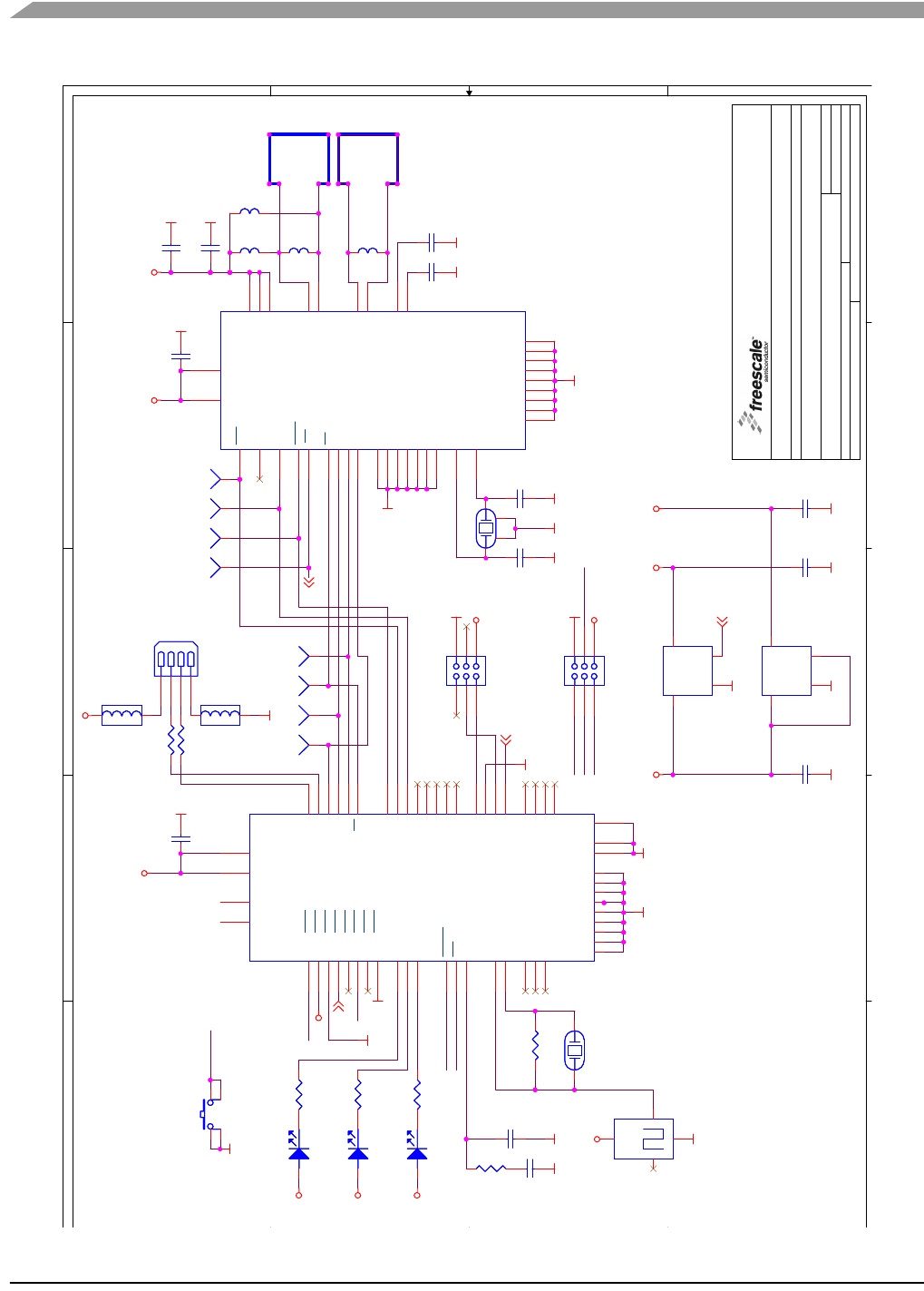
Wireless Sensing Triple Axis Reference design, Rev. 0.9
33 Freescale Semiconductor
USB stick board description
4.2.9 USB stick schematics
Figure 4-4USB stick schematics
5
5
4
4
3
3
2
2
1
1
D
C
B
A
TxD
RxD
PTA0
RxD
OSC1
MIRQ
MRESET
MIRQ
MRESET
MIRQ
OSC1
PTA0
GND
VDD36
GND
VDD33
GND
GND
GND GND
GND
GND
VDD
GND
VDD36
GND
VDDA
GND
GNDGND
VDD
GND
GND
VDD36
GNDGND
VDD33
GND
VDD36
GND
GND
GND
GND
VDD
VDD
VDD
GND
GND
VDD
GND
GND
GND
VDD36
GND
IRQ
VREG33EN
VREG33EN
IRQ
Title
Size
Design Name:
Rev
Modify Date: Sheet of
Schematic Name:
Copyright Freescale
POPI Status:
Author:
1.1
ZSTAR USB dongle
Freescale Semiconductor RCSC
1. maje 1009
756 61 Roznov p.R., Czech Republic, Europe
A4
11
Tuesday, August 08, 2006
SCHEMATIC1
General Business Information
Radomir Kozub & Pavel Lajsner
2005
X:\ICONN\IC108 - LOW-COST 2.4GHZ AND XYZ ACCELEROMETER DEMO\HW\00240\00240.DSN
Title
Size
Design Name:
Rev
Modify Date: Sheet of
Schematic Name:
Copyright Freescale
POPI Status:
Author:
1.1
ZSTAR USB dongle
Freescale Semiconductor RCSC
1. maje 1009
756 61 Roznov p.R., Czech Republic, Europe
A4
11
Tuesday, August 08, 2006
SCHEMATIC1
General Business Information
Radomir Kozub & Pavel Lajsner
2005
X:\ICONN\IC108 - LOW-COST 2.4GHZ AND XYZ ACCELEROMETER DEMO\HW\00240\00240.DSN
Title
Size
Design Name:
Rev
Modify Date: Sheet of
Schematic Name:
Copyright Freescale
POPI Status:
Author:
1.1
ZSTAR USB dongle
Freescale Semiconductor RCSC
1. maje 1009
756 61 Roznov p.R., Czech Republic, Europe
A4
11
Tuesday, August 08, 2006
SCHEMATIC1
General Business Information
Radomir Kozub & Pavel Lajsner
2005
X:\ICONN\IC108 - LOW-COST 2.4GHZ AND XYZ ACCELEROMETER DEMO\HW\00240\00240.DSN
C8
6.8pF
C8
6.8pF
C7
100pF
C7
100pF
L6
4.7nH
L6
4.7nH
R3 560R3 560
ATTNATTN
1
C1
10nF
C1
10nF
U4
NCP502SQ36T1G
U4
NCP502SQ36T1G
Vin
1Vout 5
GND
2
Enable
3
SPCLKSPCLK
1
L5
5.6nH
L5
5.6nH
R7
1M
R7
1M
C13
1uF
C13
1uF
S1
Alps SKRP
S1
Alps SKRP
1 3
42
Q2
Murata CSTCR6M00G53
Q2
Murata CSTCR6M00G53
12
L3
22nH
L3
22nH
R2 33RR2 33R
U2
MC68HC908JW32FC
U2
MC68HC908JW32FC
PTA0/KBA0
1
NC 2
NC 3
PTC1/TCLK1 4
PTC3 5
PTB5
6
PTC0/T1CH0 7
PTE7/SS 8
PTE6/MISO 9
PTE5/MOSI 10
PTE4/SPCLK 11
NC 12
PTD0 13
PTD1 14
PTD2 15
PTD3 16
PTD4 17
PTD5 18
PTD6 19
NC
21
PTD7 22
NC
23
NC
24
OSC1
25
OSC2
26
PTB0
27
PTB1
28
VSS33
29
PTE2/PS2CLK/D+ 30
PTE3/D- 31
REG33V 32
VSSPLL
33
CGMXFC
34
VDDPLL 35
PTA7/KBA7
36
RESET
37
IRQ
38
PTA6/KBA6
39 PTA5/KBA5
40
PTC2/T1CH1 41
VDD 42
REG25V 43
VSS
44
PTA4/KBA4
45 PTA3/KBA3
46 PTA2/KBA2
47 PTA1/KBA1
48
NC 20
EPGND
100 EPGND
101 EPGND
102 EPGND
103 EPGND
104 EPGND
105 EPGND
106 EPGND
107 EPGND
108
C4
100pF
C4
100pF
MOSIMOSI
1
D1
LED
D1
LED
C11
1uF
C11
1uF
C10
2n2
C10
2n2
FB1
BEAD
FB1
BEAD
12
J3
uMON08
J3
uMON08
1 2
3 4
65
D3
LED
D3
LED
RTXENRTXEN
1
L4
22nH
L4
22nH
OSC.
Q3
EPSON-SG310 4.0MHz
OSC.
Q3
EPSON-SG310 4.0MHz
3
2 4
1
D2
LED
D2
LED
U1
MC13191FC
U1
MC13191FC
RFIN- 1
RFIN+ 2
PAO+ 5
PAO- 6
GPIO4
8GPIO3
9GPIO2
10 GPIO1
11
RST
12
RXTXEN
13
ATTN
14
CLKO
15
SPICLK
16
MOSI
17
MISO
18
CE
19
IRQ
20
VDDD 21
VDDINT 22
GPIO5
23
GPIO6
24
GPIO7
25
CRYSTAL1
26
CRYSTAL2
27
VDDLO2 28
VDDLO1 29
VDDVCO 30
VBATT 31
VDDA 32
EPGND
36 EPGND
37 EPGND
38 EPGND
39 EPGND
40 EPGND
41
EPGND
35
EPGND
34
EPGND
33
R1 33RR1 33R
SSSS
1
J1
USB-A-MALE
J1
USB-A-MALE
2
1
3
4
C3
10nF
C3
10nF
Q1
16MHz NX2520SA
Q1
16MHz NX2520SA
12
3
4
R5 560R5 560
IRQIRQ
1
R6
1k
R6
1k
C12
1uF
C12
1uF
FB2
BEAD
FB2
BEAD
12
R4 560R4 560
C6
10nF
C6
10nF
C2
10nF
C2
10nF
U3
NCP502SQ33T1G
U3
NCP502SQ33T1G
Vin
1Vout 5
GND
2
Enable
3
J2
Serial
J2
Serial
1 2
3 4
65
RSTRST
1
C9
6.8pF
C9
6.8pF
MISOMISO
1
C5
10nF
C5
10nF

USB stick board description
Wireless Sensing Triple Axis Reference design, Rev. 0.9
34 Freescale Semiconductor
4.3 Bill of Materials
Table 4-1USB stick bIll of materials
Item Quantity Reference Part Manufacturer Manufacturer order code
1 5 C1,C2,C3,C5,C6 10nF TDK C1608CH1E103J
2 2 C4,C7 100pF TDK C1608CH1H101J
3 2 C8,C9 6.8pF TDK C1608CH1H070D
4 1 C10 2n2 TDK C1608CH1H222J
5 3 C11,C12,C13 1uF TDK C1608JB1C105K
6 3 D1,D2,D3 Kingbright
KP-1608SEC Kingbright KP-1608SEC
7 2 FB1,FB2 Ferrite bead TDK GLF1608T100M
8 1 J1 USB-A-MALE Molex 48037-1000
91 J2 Serial N/A
10 2 L3,L4 22nH TDK MLG1608B22NJT
11 1 L6 4.7nH TDK MLG1608B4N7ST
12 1 L5 5.6nH TDK MLG1608B5N6DT
13 1 Q1 16MHz NX2520SA NDK NX2520SA 16MHz EXS00A-02940
Specification n° EXS10B-07228
14 1 Q2 Murata
CSTCR6M00G15 Murata CSTCR6M00G15
15 2 R1,R2 33R resistor 0603
package
16 3 R3,R4,R5 560R resistor 0603
package
17 1 R6 1k resistor 0603
package
18 1 R7 1M resistor 0603
package
19 1 U1 MC13191FC Freescale MC13191FC
20 1 U2 MCHC908JW32FC Freescale MCHC908JW32FC
21 1 U3 NCP502SQ33T1G ON Semi NCP502SQ33T1G
22 1 U4 NCP502SQ36T1G ON Semi NCP502SQ36T1G
23 1 S1 switch SKRP Alps SKRPADE010 (or SKRPACE010 or
SKRPABE010)

Wireless Sensing Triple Axis Reference design, Rev. 0.9
Freescale Semiconductor 35
Chapter 5 Software Design
5.1 Introduction
This section describes the design of the ZSTAR software blocks. The software description comprises
these topics:
•SMAC (Simple Media Access Controller) modifications description
•‘Air’ ZSTAR RF protocol protocol description
• Serial STAR protocol and ZSTAR extensions (over USB) protocol description
• AN2295 Bootloader (over USB) implementation notes
5.2 SMAC (Simple Media Access Controller)
The SMAC is a simple ANSI C based code stack available as sample source code which can be used to
develop proprietary RF transceiver applications using the MC13191.
5.2.1 SMAC Features
• Compact footprint:
– 2K FLASH
– 10 bytes (+ maximum packet length) RAM
– As low as 16kHz bus clock
• Can be used to demonstrate coin cell operation for a remote control
• MC13191 compatible
• Very-low power, proprietary, bi-directional RF communication link
• ANSI C source code targeted at the HCS08 core and portable to almost any CPU core (including
4-bit)
• Low priority IRQ
• Sample application included, extremely easy to use
• Liberally commented
• Metrowerks CodeWarrior Experimental edition for support
5.2.2 Modifications of SMAC for ZSTAR demo
The development of the ZSTAR software is based on the free SMAC stack available from Freescale. The
SMAC version used was 4.1a. Two sorts of modifications were made since the original version did not
support the HC08 family or the MC9S08QG8 derivative of the 9S08 family. All changes are made using
conditional compile options, using ZSTARQG8 and ZSTARJW32 definitions.
A fully detailed description of the SMAC is in the SMAC Reference Manual (SMACRM.pdf), available
together with SMAC source code.

Software Design
Wireless Sensing Triple Axis Reference design, Rev. 0.9
36 Freescale Semiconductor
5.2.2.1 MC9S08QG8 SMAC modifications (Sensor Board)
Here the modifications of the SMAC are very minimal, since the core, peripherals and naming conventions
are the same as in the MC9S08GB/GT code (originally in the SMAC 4.1a code).
The main changes are listed below:
drivers.c:
•void MC13192Wake (void) function not implemented, ATTN pin not connected to the
microcontroller.
•void RTXENDeAssert(void) and void RTXENAssert(void) functions not implemented,
RXTXEN pin not connected to the microcontroller.
mcu_hw_config.c:
• A set of functions
void SetGPIO(unsigned char gpio);
void ClearGPIO(unsigned char gpio);
void ToggleGPIO(unsigned char gpio);
added for the purpose of driving LED’s connected to the MC13191 GPIO pins.
•void UseExternalClock(void) and void UseMcuClock(void) functions not implemented,
no external clock available to the microcontroller.
• RESET pin handling in void MC13192Restart(void) and void
MC13192ContReset(void) functions omitted since the RESET pin is not connected to the
microcontroller.
• RESET, ATTN and RXTXEN pins handling in void GPIOInit(void) and void
MCUInit(void) functions omitted since these pins are not connected to the microcontroller.
• LED toggling added into void MCUInit(void) during the waiting for MC13191 to initialize.
device_header.h:
• Several SPI, TPM and SOPT definitions added at the top of the standard <mc9s08qg8.h> header
file.
created port_config_ZSTARQG8.h file with target specific defines (GPIO assignments, etc.)
5.2.2.2 MCHC908JW32 SMAC modifications (USB stick)
There are several modifications of SMAC required to
1. compile for the HC08 family member MCHC908JW32
2. reflect that the MC13191 connects to the microcontroller in a slightly different way (as described in
chapter 4.2.3 MC13191 to MCHC908JW32 microcontroller interface) - namely, MC13191’s IRQ
pin.
The 9S08 to HC908 porting required slight changes in the following files:
mcu_spi_config.c:
•void SPIInit(void) function modified to initialize the HC908 SPI module.
mcu_spi_config.h:
•SPIWaitTransferDone(), SPIClearRecieveStatReg(),
SPIClearRecieveDataReg(), SPISendChar(u8Char) and SPIRead() macros changed to
work with the HC908 SPI module.

SMAC (Simple Media Access Controller)
Wireless Sensing Triple Axis Reference design, Rev. 0.9
Freescale Semiconductor 37
Further changes are relevant to the ZSTAR JW32 platform and specific connections:
drivers.h:
•CLEAR_IRQ_FLAG macro changed to reflect KBI module serving IRQ requests from MC13191.
mcu_hw_config.c:
•void UseExternalClock(void) and void UseMcuClock(void) functions no implemented,
no external clock available to the microcontroller.
• LED toggling added into void MCUInit(void) during waiting for MC13191 to initialize.
•UINT8 IRQPinLow(void) function returns the state of the pin PTA3/KBI3 instead of the IRQ pin.
mcu_hw_config.h:
•IRQFLAG, IRQACK(), IRQInit() and IRQPinEnable() macros changed to reflect KBI
module serving IRQ requests from the MC13191.
device_header.h:
• Several KBI definitions added at the top of the standard <mc68hc908jw32.h> header file.
created port_config_ZSTARJW32.h file with target specific defines (GPIO assignments, etc.)
5.2.2.3 Generic SMAC modifications (USB stick + Sensor Board)
Several modifications of SMAC have been made in order to improve the behavior with some older
MC13191 silicon versions. Namely a software time-out functions (using microcontroller’s TIM/TPM timer
functions) have been added into UINT8 PDDataRequest(tTxPacket *psPacket)and UINT8
PLMEEnergyDetect (void) functions in simple_phy.c file.
Both functions wait for the gu8RTxMode variable to change to IDLE_MODE. This variable should change
in the void interrupt IRQIsr(void) function once the execution of a specified task (in MC13191)
finishes. Under some rare circumstances, an IRQ event (and also an IRQIsr() interrupt) does not occur,
so this software workaround has been implemented to avoid a software lock-up.
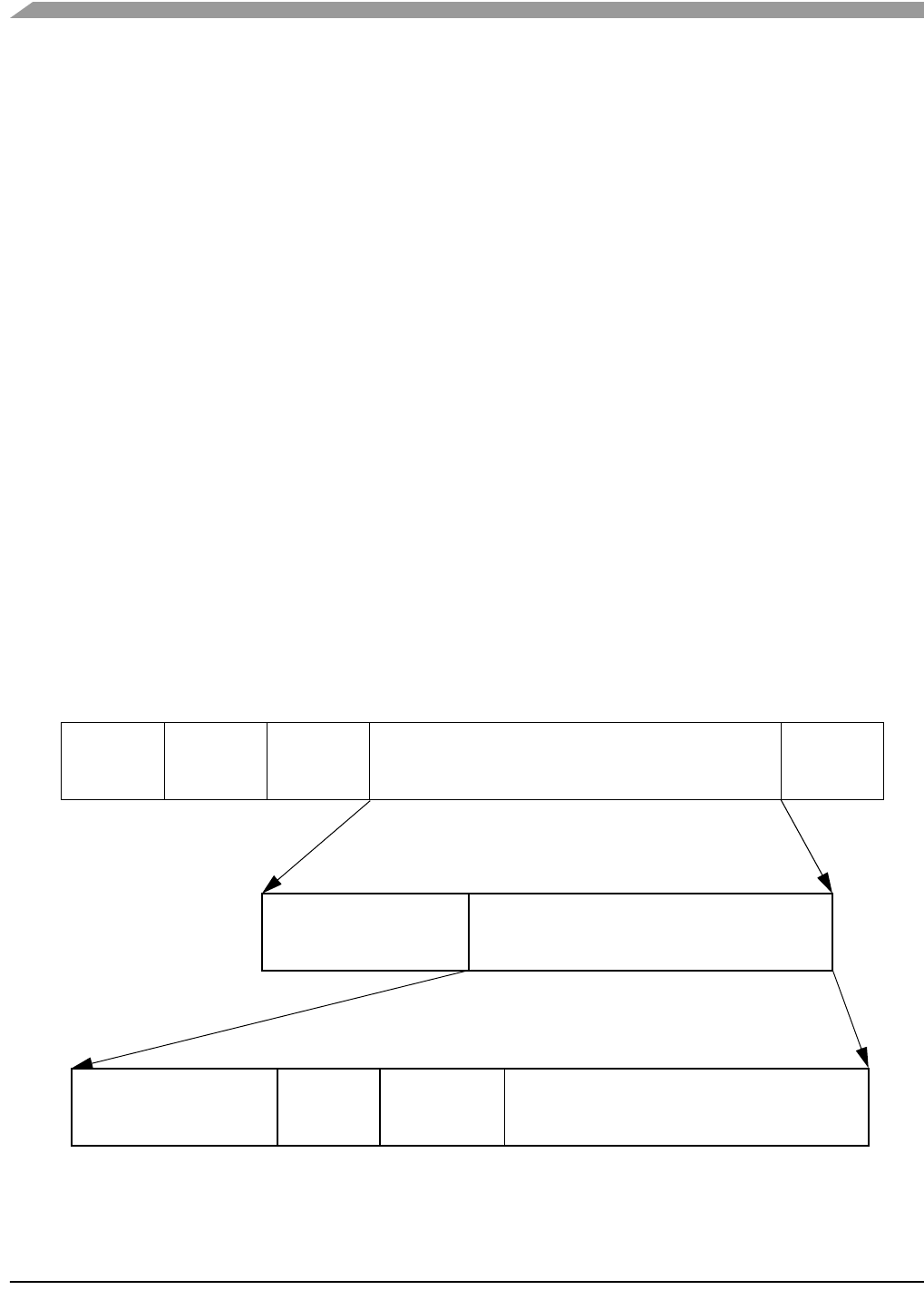
Software Design
Wireless Sensing Triple Axis Reference design, Rev. 0.9
38 Freescale Semiconductor
5.3 ZSTAR RF protocol
The ZSTAR demo uses very simple protocol to transfer the accelerometer, button and calibration data
between the Sensor Board and the USB stick over the RF medium. The protocol is built on top of SMAC
(Simple Media Access Controller) drivers that are available for the MC13191 transceivers family. The
protocol is bidirectional allowing the set up of independent connections amongst numerous pairs of
ZSTAR demos.
All data is transferred in so-called Zpackets. This protocol is primarily targeted at simple demo purposes,
allowing a fast transfer of the accelerometer data in short packets with minimum overheads and with
minimum battery loads (most of the receive windows eliminated, short transmit packets, etc.).
5.3.1 Zpacket format
The ZSTAR Zpacket is contained inside the MC13191 standard packet structure, which is consistent with
the IEEE 802.15.4 Standard. The SMAC library transparently adds a 16 bit Packet control field (see
chapter 7.2.1.1 of IEEE 802.15.4 Standard specifications) to differentiate packets from ZigBee and other
standards.
The Zpacket becomes a payload data for the SMAC standard packet and contains the following fields:
•Network number
•RX strength
•Zcommand
•Zdata
Figure 5-1Zpacket format
Preamble SFD FLI Payload Data FCS
MC13191 Packet Structure SFD (Start of Frame Delimiter)
FLI (Frame Length Indicator)
FCS (Frame Check Sequence)
Network number RX
strength Zcommand Zdata
ZSTAR Zpacket Structure
Packet control SMAC payload
SMAC Packet Structure
field

ZSTAR RF protocol
Wireless Sensing Triple Axis Reference design, Rev. 0.9
Freescale Semiconductor 39
5.3.1.1 Network number
The network number is randomly generated at the beginning of the connection between the USB stick
and the Sensor Board. It is used to determine between various connections. Packets with different
Network numbers are simply ignored.
This field is 16 bits long.
5.3.1.2 RX strength
This field reports the strength of the last received packet on the other end of the connection. This value
simply tells us how well the other side receives ‘our packets’. This can be used by transmission power
management functions to change the transmission power if the other party receives packets with enough
strength.
The values reported are retrieved using the MLMELinkQuality() SMAC primitive.
This field is 8 bits long.
5.3.1.3 Zcommand
The ZSTAR demo protocol uses a few simple commands to establish and maintain the data flow between
the Sensor Board and USB stick.
The command is carried in Zcommand field and is 8 bits long. The commands are defined as listed in
Table 5-1.
5.3.1.4 Zdata
The Zdata field follows the Zcommand field and may be empty if the actual command doesn’t require any
additional data. The data format is dependent on the Zcommand. A detailed description is in the next
chapter.
Table 5-1ZSTAR Zcommand List
ZCommand ZCommand
code Direction Zdata
ZSTAR_BROADCAST ‘B’ (0x42) USB stick to Sensor Board none
ZSTAR_ACK ‘A’ {0x41) USB stick to Sensor Board none
ZSTAR_CALIB ‘K’ (0x4B) USB stick to Sensor Board calibration data to Sensor Board
ZSTAR_STATUS ‘S’ (0x53) USB stick to Sensor Board g-range selection data to Sensor Board
ZSTAR_CONNECT ‘C’ (0x43) Sensor Board to USB stick calibration data from Sensor Board
ZSTAR_DATA ‘D’ (0x44) Sensor Board to USB stick
accelerometer values,
button levels,
g-range selection

Software Design
Wireless Sensing Triple Axis Reference design, Rev. 0.9
40 Freescale Semiconductor
5.3.2 ZSTAR protocol Zcommand description
5.3.2.1 ZSTAR_BROADCAST
This command is sent when the USB stick tries to establish connection with the Sensor Board. The USB
stick first generates a new random network number which is then ‘broadcast’ to any Sensor Board that is
not yet connected to a USB stick. The USB stick transmits this command on a free channel, while the
Sensor Board searches all available channels. Once a Sensor Board receives this command, it responds
with a ZSTAR_CONNECT.
5.3.2.2 ZSTAR_CONNECT
This command is a reply to ZSTAR_BROADCAST, ZSTAR_CALIB or ZSTAR_STATUS commands sent
by the USB stick. The Zdata field contains the calibration data stored in the Sensor Board, in the following
format:
Figure 5-2ZSTAR_CONNECT Zdata format
5.3.2.3 ZSTAR_DATA
Once the connection is established, the Sensor Board starts to periodically transmit accelerometer, button
and g-range status data towards the USB stick.
The Zdata field contains 4 bytes; the actual X, Y and Z accelerometer values and a byte with status
information.
Figure 5-3ZSTAR_DATA Zdata format
Each transmission of a ZSTAR_DATA packet is acknowledged by a ZSTAR_ACK packet from the USB
stick, although the Sensor Board does not always open the reception window to receive this
acknowledgement, in order to save the battery charge.
Xvalue (0g) Xvalue (1g) Yvalue (0g) Yvalue (1g) Zvalue (0g) Zvalue (1g)
012 345
Zdata bytes:
Xvalue Yvalue Zvalue Status
012 3
msb lsb
Button1
Button2
unused
g-range
015-276bits:
Zdata bytes:

ZSTAR RF protocol
Wireless Sensing Triple Axis Reference design, Rev. 0.9
Freescale Semiconductor 41
5.3.2.4 ZSTAR_ACK
This command is sent as the data acknowledgement so the Sensor Board board knows that the
connection is still alive. If the receive window is opened by the Sensor Board and the ZSTAR_ACK has
not been received, the operation (periodic transmission of a ZSTAR_DATA packet) continues but the
Sensor Board will try to receive an acknowledgement more frequently. If the acknowledgement is not
received several times, the connection is dropped and the Sensor Board will try to re-establish the
connection again. The USB stick will recognize this situation once several ZSTAR_DATA packets have
not been received.
5.3.2.5 ZSTAR_CALIB
This command carries the calibration data provided by the USB stick for the Sensor Board and is sent
instead of a ZSTAR_ACK packet. The calibration data is intended to be stored in Flash memory of the
Sensor Board. Since the Sensor Board does not receive after every ZSTAR_DATA packet, the USB stick
keeps sending a ZSTAR_CALIB until the Sensor Board confirms reception using a new
ZSTAR_CONNECT packet.
5.3.2.6 ZSTAR_STATUS
This command carries the g-range data provided by the USB stick for the Sensor Board and is sent
instead of a ZSTAR_ACK packet. The g-range data is intended to switch the g-range of accelerometer
sensor. Since the Sensor Board does not receive after every ZSTAR_DATA packet, the USB stick keeps
sending a ZSTAR_STATUS until the Sensor Board confirms reception using a new ZSTAR_CONNECT
packet.

Software Design
Wireless Sensing Triple Axis Reference design, Rev. 0.9
42 Freescale Semiconductor
5.4 STAR protocol and ZSTAR extensions (over USB)
The ZSTAR demo uses a subset of the original STAR demo protocol commands. This way, most of the
software originally developed for the RD3112 (STAR) is also usable with the ZSTAR.
The STAR demo communicates over the RS232 serial line with a simple text-based protocol. The same
protocol is used in ZSTAR for communication between the USB stick and a PC (over a virtual serial port).
The PC application sees the same interface (serial port) and the same protocol as if a STAR demo was
connected.
5.4.1 Communication handshake ‘R’ (0x52)
Initially, a handshake (commands needed to test/establish the connection between the PC and the
ZSTAR demo) is conducted. This is accomplished by the PC sending an ‘R’ command, the ZSTAR demo
responding with ‘N’. In this way, the PC application sees that the demo is ready for communication.
Communication is reset, and any debug or system modes are disabled.
Figure 5-4Communication handshake ‘R’ (0x52)
5.4.1.1 Extended Communication handshake ‘r’ (0x72)
To determine whether a ZSTAR or STAR demo is connected, Only the ZSTAR demo implements an
Extended Handshake Communiation command. Once the PC sends the ‘r’ command, the ZSTAR demo
responds with a ‘Z’.
Figure 5-5Extended Communication handshake ‘r’ (0x72)
5.4.2 Accelerometer data transfer ‘V’ (0x56)
The PC sends the Values ‘V’ command, the demo responds with 6 bytes in the following sequence:
'x', X-value, 'y', Y-value, 'z', Z-value, simply an ‘x’ character followed by the actual X-axis accelerometer
binary value, then a ‘y’ followed by the actual Y-axis accelerometer binary value and a ‘z’ followed by the
actual Z-axis accelerometer binary value. Since the ZSTAR demo caches the last (over the air)
transmitted values, these values are immediately provided to the PC.
PC to demo
demo to PC
‘R’
‘N’
PC to demo
demo to PC
‘r’
‘Z’

STAR protocol and ZSTAR extensions (over USB)
Wireless Sensing Triple Axis Reference design, Rev. 0.9
Freescale Semiconductor 43
Figure 5-6Accelerometer data transfer ‘V’ (0x56)
5.4.2.1 Extended Accelerometer data transfer ‘v’ (0x76)
The ZSTAR demo has also two buttons designed on the Sensor Board. To acquire the actual state of
these buttons, the original ‘V’ command has been extended to a ‘v’ command, that provides the same
information, followed by a ‘b’ character and a binary byte containing the actual state. The least two
significant bits are used, the others are reserved. If a button is pressed, the actual bit is set to ‘1’, and if
depressed, the bit is ‘0’.
Figure 5-7Extended Accelerometer data transfer ‘v’ (0x76)
5.4.3 Calibration data ‘K’ (0x4B)
The calibration data is the accelerometer values for specific g (acceleration) levels. The values for 0g and
1g (Earth gravity) are provided for each axis. The values are stored in the Flash memory of the Sensor
Board and are transferred to the USB stick once the air connection is established (as described in chapter
5.3.2.2 ZSTAR_CONNECT). These values are stored in the USB stick for retrieval by the PC using the
‘K’ command.
The PC sends the Calibration data ‘K’ command, the demo responds with 9 bytes in the following
sequence:
'X', Xval0, Xval1, 'Y', Yval0, Yval1, Z', Zval0, Zval1, simply an ‘X’ character followed by the 0g and 1g
X-axis calibration accelerometer binary values, and the same for Y- and Z-axis.
PC to demo
demo to PC
X-axis value
‘x’ Y-axis value
‘y’ Z-axis value
‘z’
‘V’
PC to demo
demo to PC
X-axis value
‘x’
‘v’
Y-axis value
‘y’ Z-axis value
‘z’ buttons
‘b’

Software Design
Wireless Sensing Triple Axis Reference design, Rev. 0.9
44 Freescale Semiconductor
Figure 5-8Calibration data ‘K’ (0x4B)
5.4.4 Calibration process ‘k’ (0x6B)
The calibration process is initiated by a ‘k’ command from the PC, followed by 6 bytes of calibration data.
These are to be stored in the Flash memory of the Sensor Board being used. More in chapter 5.3.2.5
ZSTAR_CALIB.
The calibration data is just 6 bytes in the following sequence:
Xval0, Xval1, Yval0, Yval1, Zval0, Zval1 - 0g and 1g calibration accelerometer binary values for X-, Y-
and Z-axis. No response from the demo is provided. Verification of the calibration data stored can be done
using the Calibration data ‘K’ (0x4B) command.
Figure 5-9Calibration process ‘k’ (0x6B)
5.4.4.1 Remaining STAR demo commands
The remaining STAR commands, such as 'F', 'G', 'H', '0', '1', '2', '3' and 'E' are not implemented in the
ZSTAR demo.
5.4.5 Additional ZSTAR commands
5.4.5.1 g-select reading ‘G’ (0x47)
The ZSTAR demo allows dynamic selection of the g-range for the accelerometer sensor (see details in
chapter 3.4.2 g-select connections), thus additional commands are implemented to read and change the
g-range.
When the PC issues a ‘G’ command, the ZSTAR demo responds with the g-range actually selected. A ‘0’,
‘1’, ‘2’ or ‘3’ character is returned where ‘0’ is for the 1.5g range, ‘1’ for 2.0g , ‘2’ for 4.0g and ‘3’ for the
6.0g range. If a different sensor (e.g. MMA7261Q) is implemented on the Sensor Board, the g-ranges are
2.5g, 3.3g, 6.7g and 10g respectively.
PC to demo
demo to PC
x(0g)
‘X’ ‘Y’ ‘Z’
‘K’
x(1g) y(0g) y(1g) z(0g) z(1g)
PC to demo
demo to PC
x(0g)
‘k’ x(1g) y(0g) y(1g) z(0g) z(1g)

STAR protocol and ZSTAR extensions (over USB)
Wireless Sensing Triple Axis Reference design, Rev. 0.9
Freescale Semiconductor 45
Figure 5-10g-select reading ‘G’ (0x47)
5.4.5.2 g-select setting ‘g’ (0x67)
To select the g-range of the sensor on the ZSTAR Sensor Board, a ‘g’ command is issued. It needs to be
followed by the required g-range (‘0’, ‘1’, ‘2’ or ‘3’). The USB stick board then communicates this selection
to the Sensor Board over the air (see more in 5.3.2.6 ZSTAR_STATUS).
No response from the demo is provided. To verify which g-range has been selected, the g-select reading
‘G’ (0x47) command can be used.
Figure 5-11g-select setting ‘g’ (0x67)
5.4.5.3 Info ‘I’ (0x49)
The Info command ‘I’ has only been added to determine which version, compile date, and author of the
USB stick software has been implemented. The demo returns a plain text information, and this command
is usually issued over terminal (e.g. HyperTerminal) software.
Figure 5-12Info ‘I’ (0x49)
5.4.5.4 Debug on ‘U’ (0x55) and Debug off ‘u’ (0x75)
Various debug information can be observed after issuing a ‘U’ command, usually in terminal (e.g.
HyperTerminal) software. Mainly, information on the air protocol is displayed in text, information on the
detected channel energy during the surveying for a free channel is shown, channel numbers, and, once
the connection is established, the network number. The received level of packets from the Sensor Board
PC to demo
demo to PC
‘G’
g-select value
PC to demo
demo to PC
‘g’ g-select value
PC to demo
demo to PC
‘I’
info text, version, date, etc.

Software Design
Wireless Sensing Triple Axis Reference design, Rev. 0.9
46 Freescale Semiconductor
and the reported USB stick packet level are shown, as well as command names, etc. This can be useful
in determining the communication range between the USB stick and the Sensor Board.
The debug information is no longer displayed after issuing a ‘u’ command or Communication handshake
‘R’ (0x52).
Figure 5-13Debug on ‘U’ (0x55) and Debug off ‘u’ (0x75)
5.4.6 Further debug and test commands
5.4.6.1 Forced channel number selection
In order to allow effective testing and debugging, few additional commands have been added. If, before
a connection between the USB stick and Sensor Board is established, any hexadecimal number
command (‘0’ through ‘9’ or ‘A’ through ‘F’) is sent, the connection will be established on this specific
channel number (0 to 15). Any new channel can be selected, sending the new channel number command.
The selection becomes effective during the new connection is being established.
The return to the automatic mode (where a random channel with the minimum energy is selected) can be
forced only by a complete software reset (ie. removing the USB stick from the USB slot).
5.4.6.2 Semiautomatic self-calibration
For the purpose of easier semiautomatic calibration of the ZSTAR demo, additional Calibration command
‘Q’ (0x51) has been added. This command is usually issued over terminal (e.g. HyperTerminal) software.
A user is required to place the Sensor Board into 3 specific positions, in which the Earth gravity will induce
a maximum acceleration in each of X, Y, and Z axes. Before issuing the first ‘Q’ command, the Sensor
Board must be placed flat, ie. with Z-axis aiming toward the Earth core. For the second issue of ‘Q’
calibration command, the board’s X-axis has to aim toward the Earth core. The board should ‘stay’ on its
right edge. Next, the Y-axis is calibrated, with the board ‘staying’ on its top edge. Finally, after issuing the
fourth ‘Q’ command, the calibration data are sent to the Sensor Board, actually using ZSTAR_CALIB
command. The text help is provided during the self-calibration process.
PC to demo
demo to PC
‘U’
various debug information
‘u’
no debug info
mainly on air protocol

Bootloader
Wireless Sensing Triple Axis Reference design, Rev. 0.9
Freescale Semiconductor 47
5.5 Bootloader
There’s bootloader software implemented in MCHC908JW32 microcontroller. The bootloader is based on
AN2295 Application note - Developer’s Serial Bootloader for M68HC08 and HCS08 MCUs and
AN2295SW accompanied software. The original AN2295 bootloader targets serial connections between
the PC and applications, and since the MCHC908JW32 implements a virtual serial port application, the
USB version of the AN2295 bootloader has been created to allow reprogramming of Flash memory in the
USB stick.
The USB virtual serial port software is fully described in AN3153 Application note - Using the Full-Speed
USB Module on the MCHC908JW32; the MCHC908JW32 bootloader implements the same virtual serial
port but under a different PID (the PC sees that serial port as a different application from ZSTAR).
The bootloader drivers installation guide can be found in chapter 6.1.2 AN2295 Bootloader Drivers
installation.
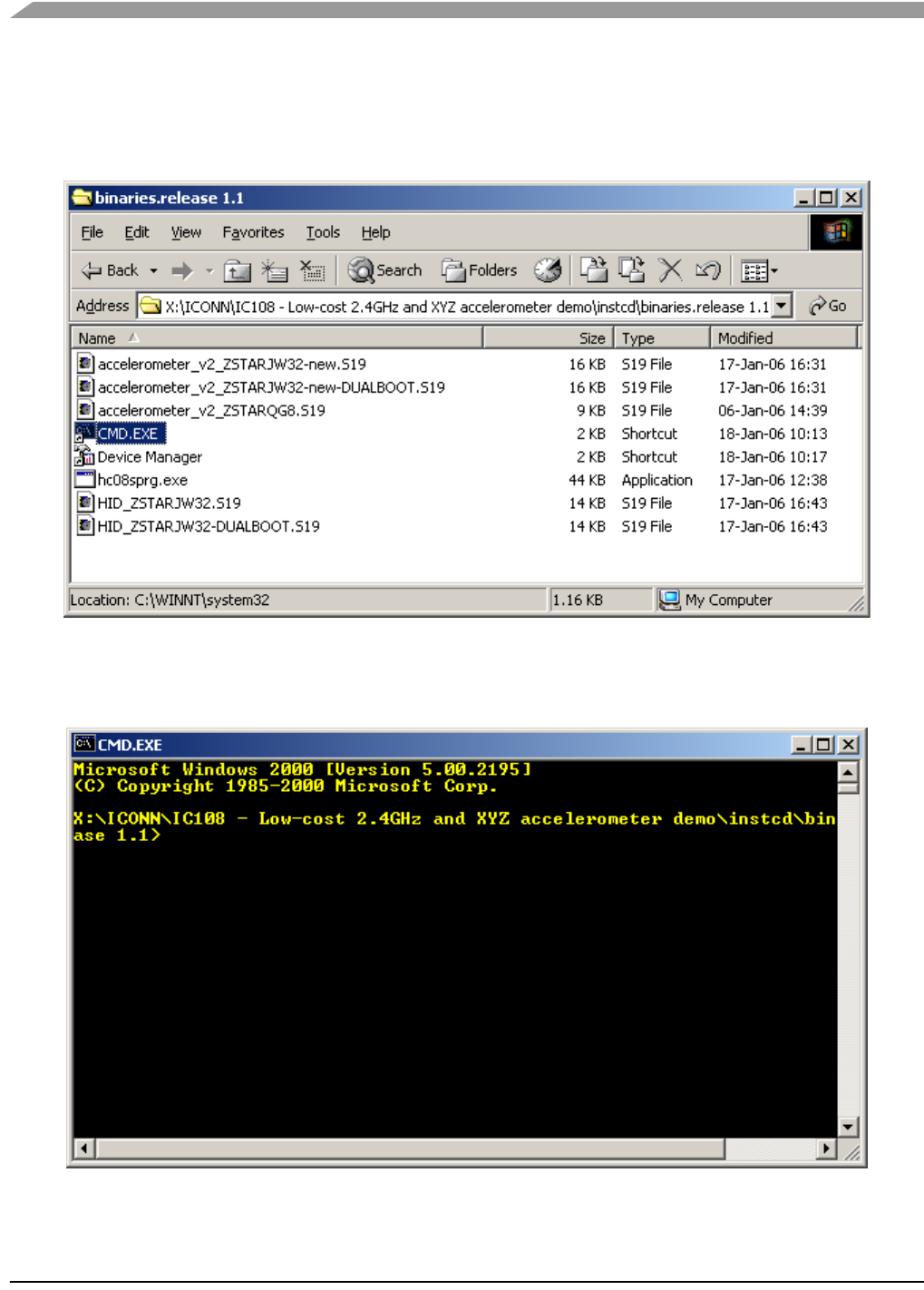
Software Design
Wireless Sensing Triple Axis Reference design, Rev. 0.9
48 Freescale Semiconductor
5.5.1 Bootloading procedure
1. Find on the installation CD the folder with binaries:
2. Start (double-click) the CMD.EXE shortcut, a command line window should appear:
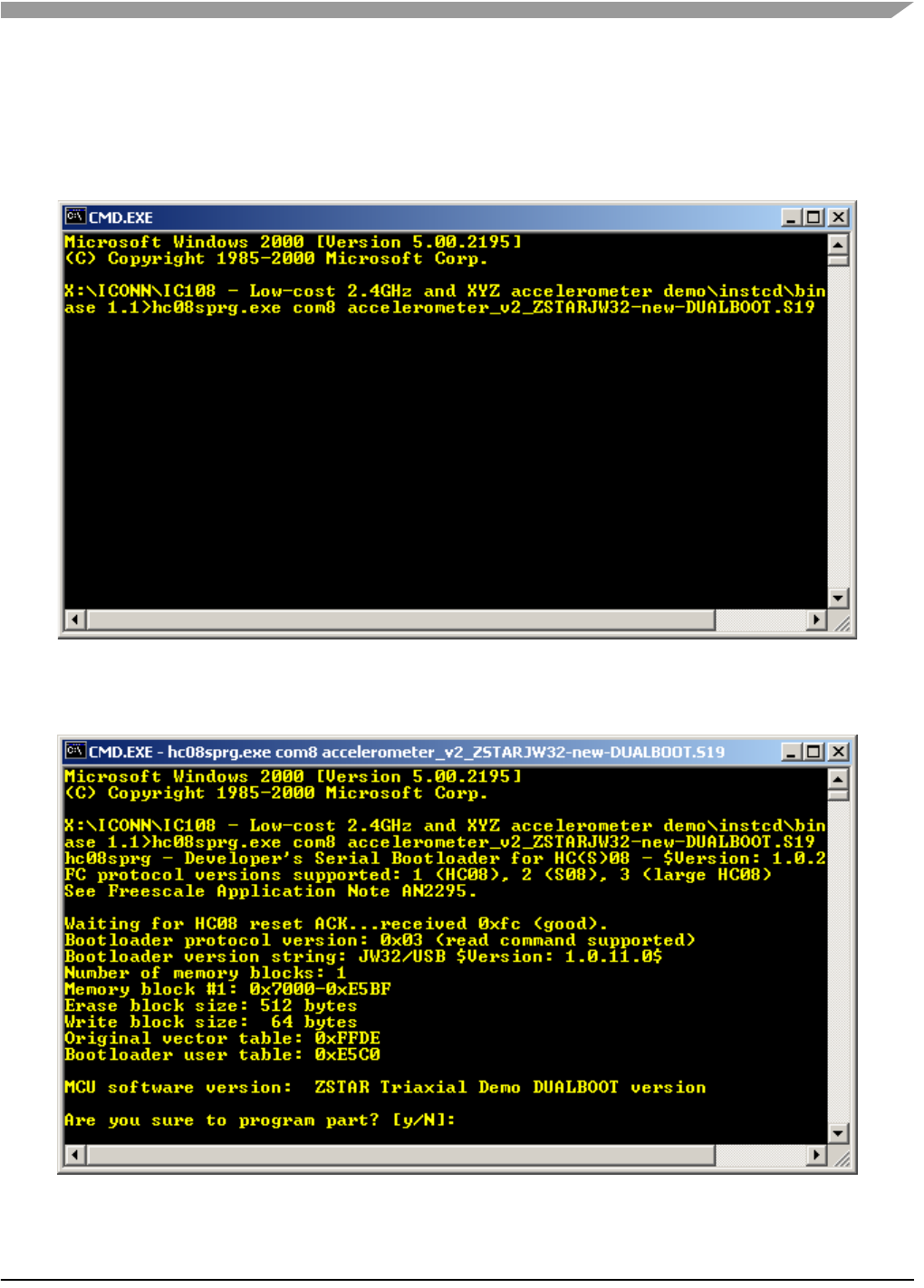
Bootloader
Wireless Sensing Triple Axis Reference design, Rev. 0.9
Freescale Semiconductor 49
3. Now type: hc08sprg [bootloader com port number] [binary (S file) that you want to bootload], just
like this:
hc08sprg.exe com8 accelerometer_v2_ZSTARJW32-new-DUALBOOT.S19
4. Press ENTER and initial bootloader communication will start:
If this screen does not appear, remove the USB stick and start from the beginning.
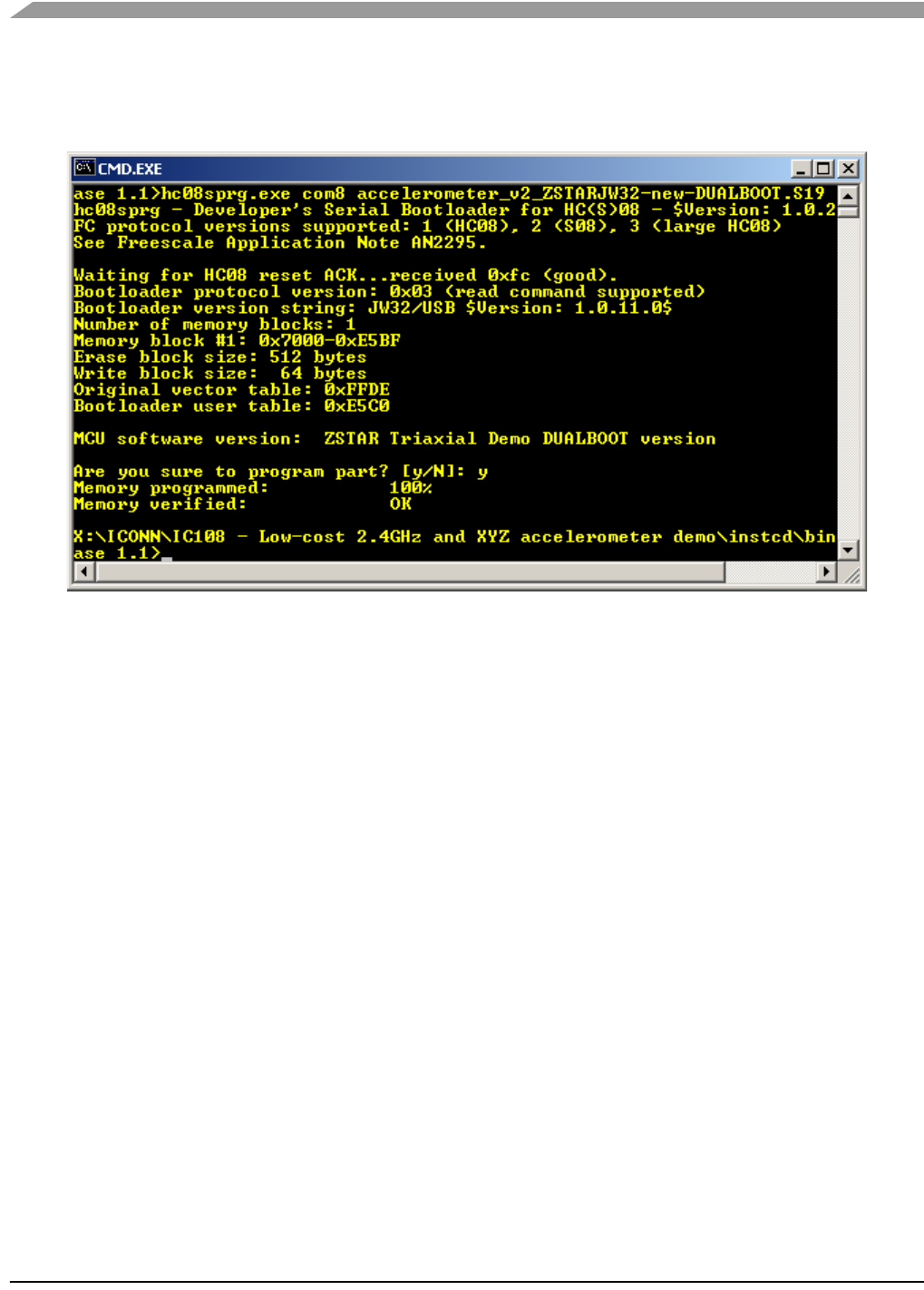
Software Design
Wireless Sensing Triple Axis Reference design, Rev. 0.9
50 Freescale Semiconductor
5. Just confirm with Y, and the binary will be loaded onto the USB stick:
The bootloader disappears (in Device Manager) and the newly loaded software starts to execute.
Using this procedure the software in the USB stick can be changed anytime.
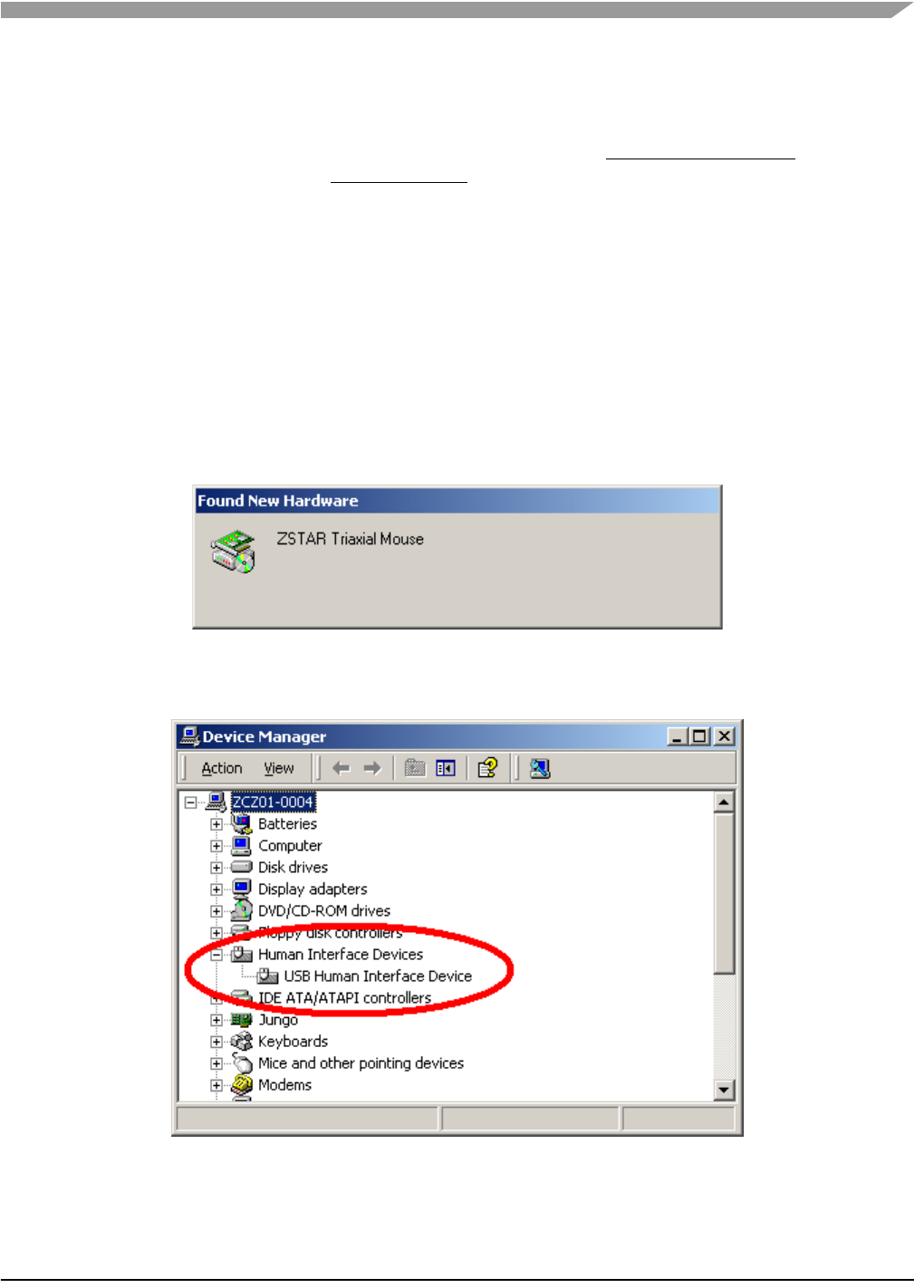
Bootloader
Wireless Sensing Triple Axis Reference design, Rev. 0.9
Freescale Semiconductor 51
5.5.2 Dualboot guidelines
NOTE: The USB stick already comes from factory with two dualboot-aware applications pre-programmed.
USB stick and AN2295 Bootloader software provide a way of having two different software (devices) in
one USB stick. In order to do this, two dualboot-aware versions of the software needs to be consecutively
bootloaded onto the USB stick:
Follow the sequence of instructions in the 5.5.1 Bootloading procedure for two dualboot versions of
software:
1. First bootload accelerometer_v2_ZSTARJW32-new-DUALBOOT.S19.
After bootloading, ZSTAR Triaxial Demo (COM1) should appear in Device Manager.
2. Next, remove the USB stick again, press the button, re-insert the stick and bootload
HID_ZSTARJW32-DUALBOOT.S19 software in.
After bootloading, a new device (ZSTAR Triaxial Mouse) should appear:
The ‘tilt’ mouse will install automatically and also appear in the Device Manager:

Software Design
Wireless Sensing Triple Axis Reference design, Rev. 0.9
52 Freescale Semiconductor
5.5.2.1 Dualboot applications switching
Having both dualboot-aware applications programmed in the USB stick, they can be switched just by
quickly pressing the button (having the USB stick inserted into the USB slot). The applications will appear
and disappear accordingly.
The ‘tilt’ mouse application in order to work must have sensor board calibrated correctly (e.g. using
RD3152MMA7260Q_SW.exe or 5.4.6.2 Semiautomatic self-calibration procedure).

Wireless Sensing Triple Axis Reference design, Rev. 0.9
Freescale Semiconductor 53
Chapter 6
Application Setup
6.1 ZSTAR Installation Procedure
6.1.1 USB stick installation
First of the all, we have to install the USB stick to your PC. Please follow the next steps.
1. Plug the USB stick into a USB slot.The ‘Found New Hardware’ announcement should appear:
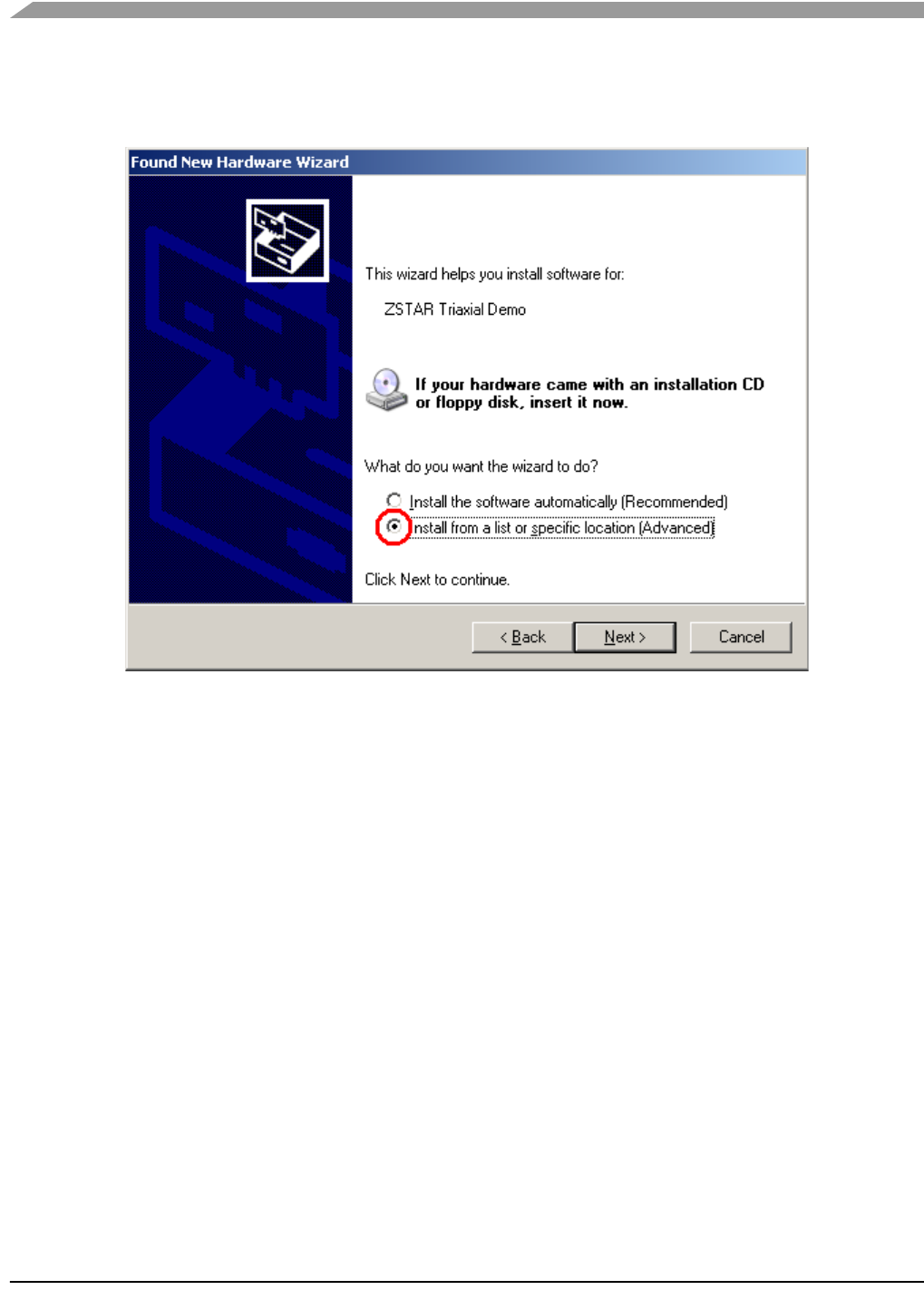
Application Setup
Wireless Sensing Triple Axis Reference design, Rev. 0.9
54 Freescale Semiconductor
2. Then the installation wizard starts for new hardware. Choose “Install from a list or special location“
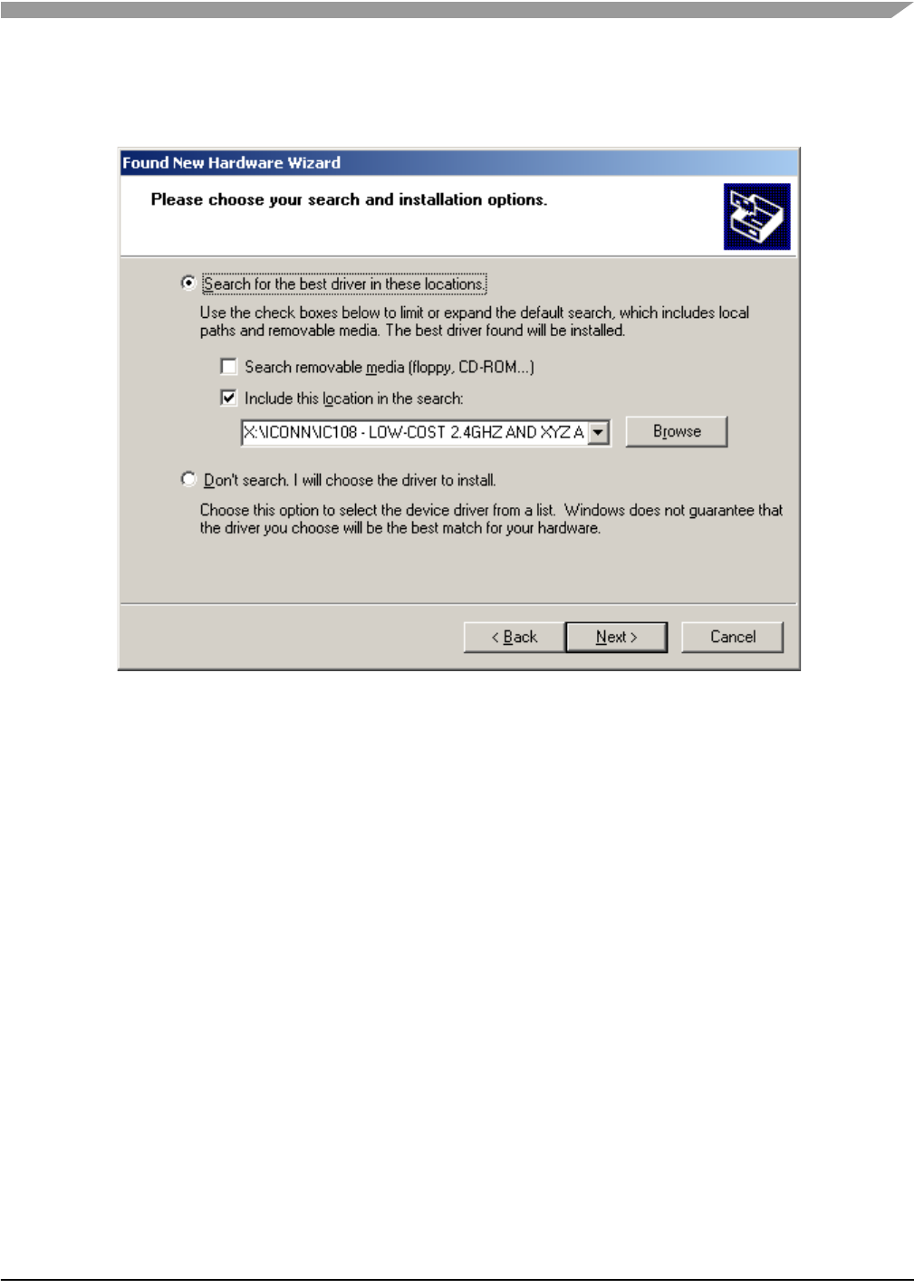
ZSTAR Installation Procedure
Wireless Sensing Triple Axis Reference design, Rev. 0.9
Freescale Semiconductor 55
3. Point to the Installation CD as the driver path:
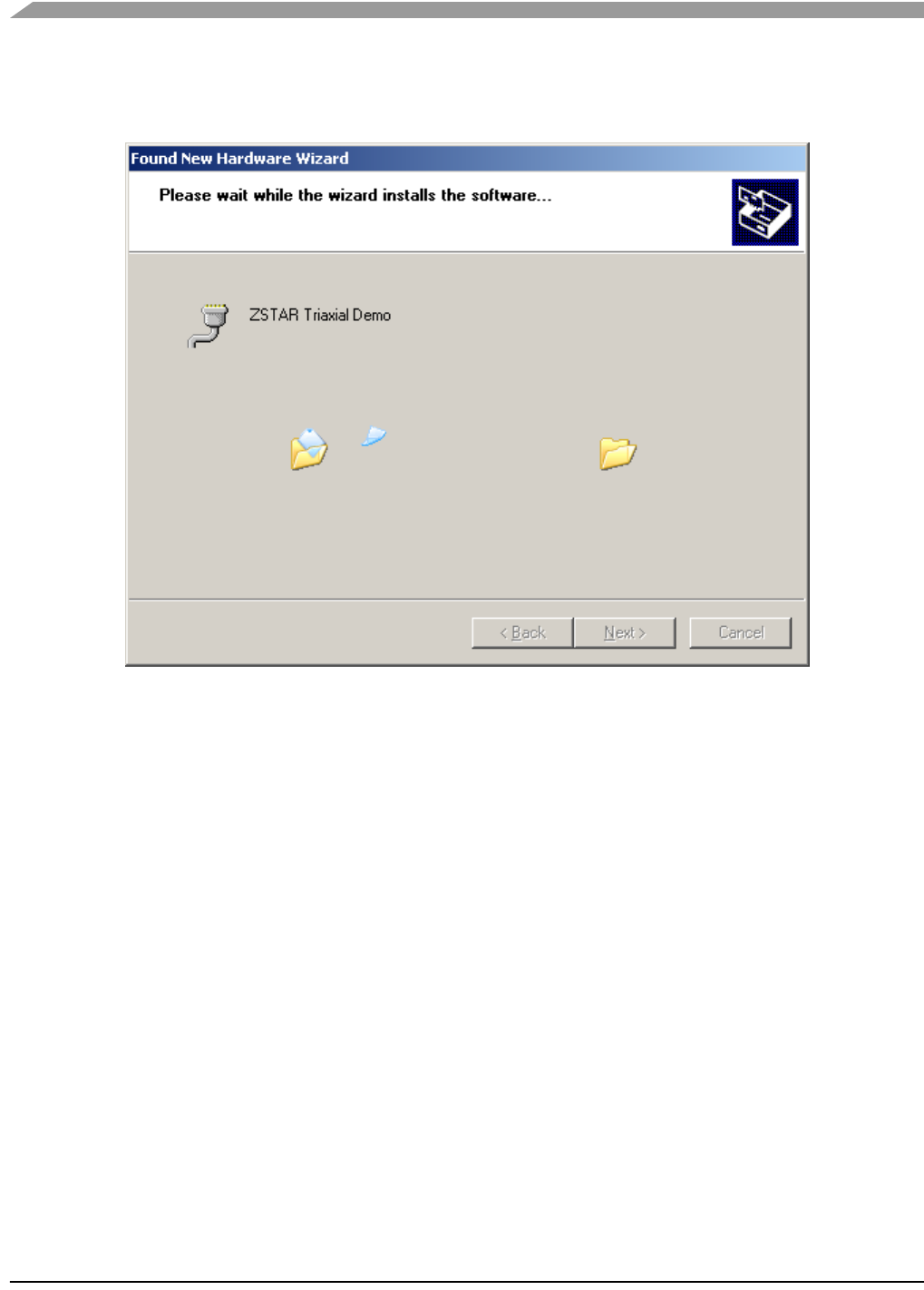
Application Setup
Wireless Sensing Triple Axis Reference design, Rev. 0.9
56 Freescale Semiconductor
4. Installation should continue:
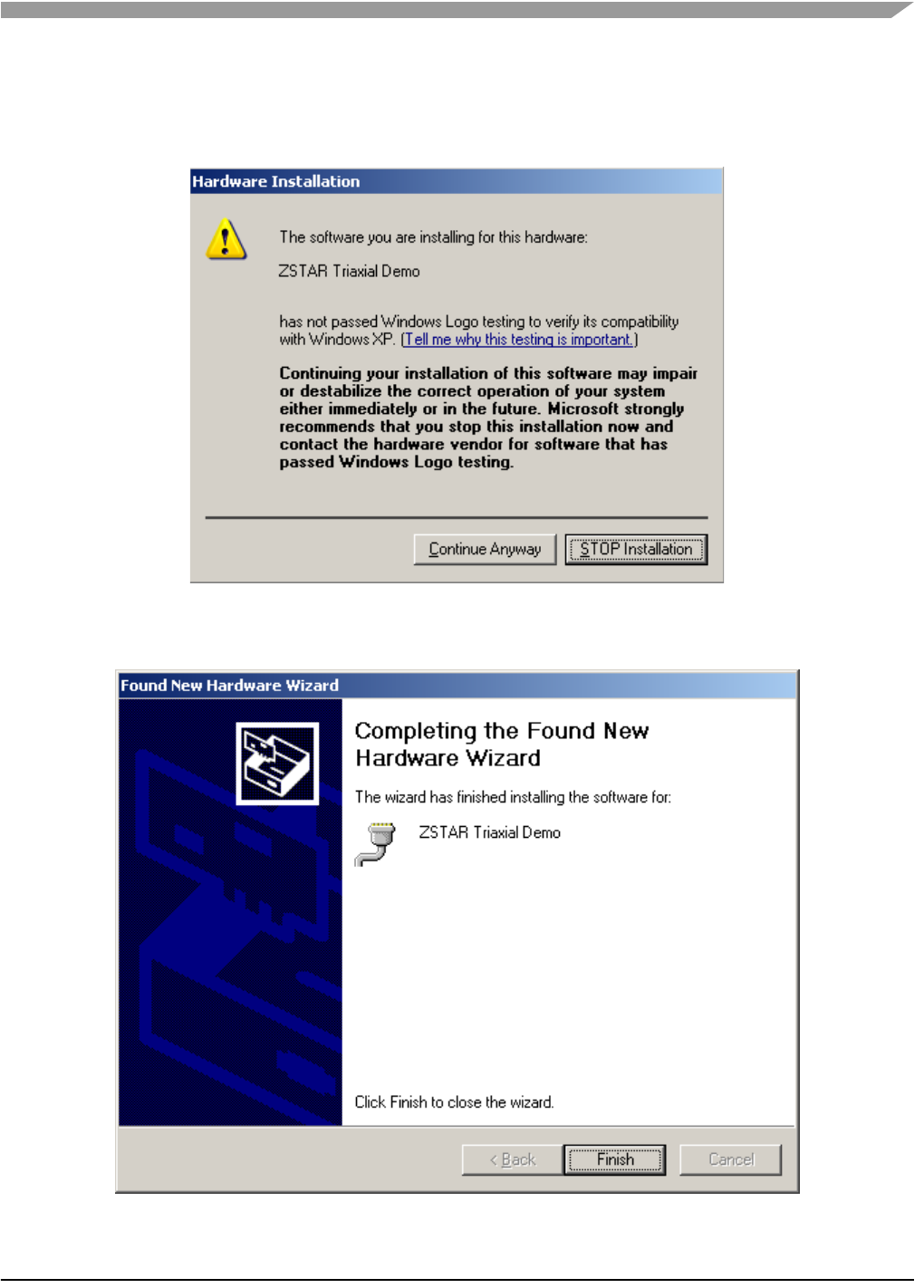
ZSTAR Installation Procedure
Wireless Sensing Triple Axis Reference design, Rev. 0.9
Freescale Semiconductor 57
5. If you are using Windows XP SP2, you will be asked to stop or continue installation because the
drivers are not certified by Microsoft. Select the “Continue Anyway” button
6. Installation should succesfully finish.
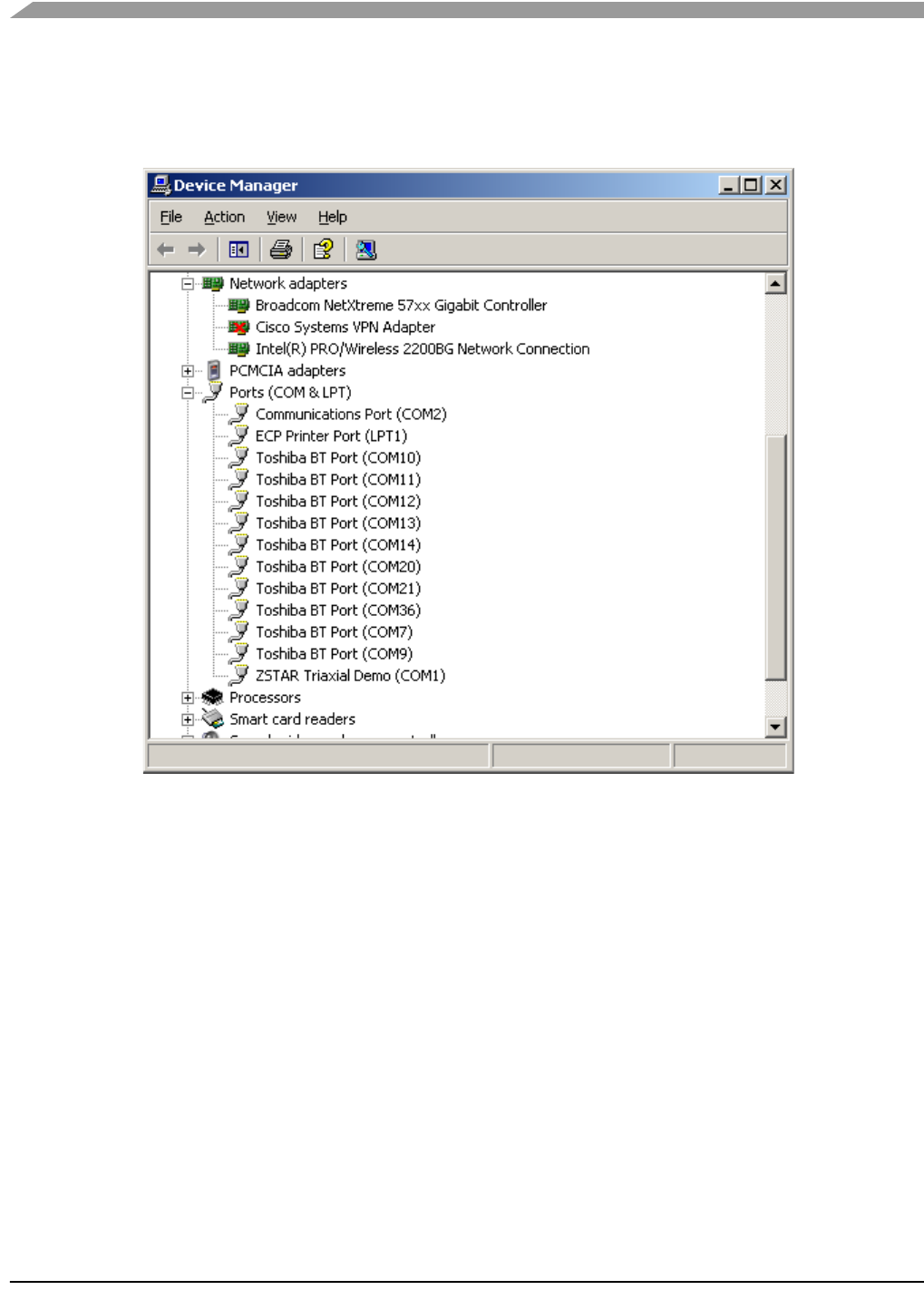
Application Setup
Wireless Sensing Triple Axis Reference design, Rev. 0.9
58 Freescale Semiconductor
7. Check whether a new serial port (ZSTAR Triaxial Demo) has appeared in your Device Manager
(My Computer, right click, Manage, Device Manager):
8. If required, the ZSTAR Triaxial Demo COM port maybe renumbered using the standard procedure
in Windows operating system:
Right click for Properties, Port Settings tab, Advanced button and change the COM port number
accordingly.
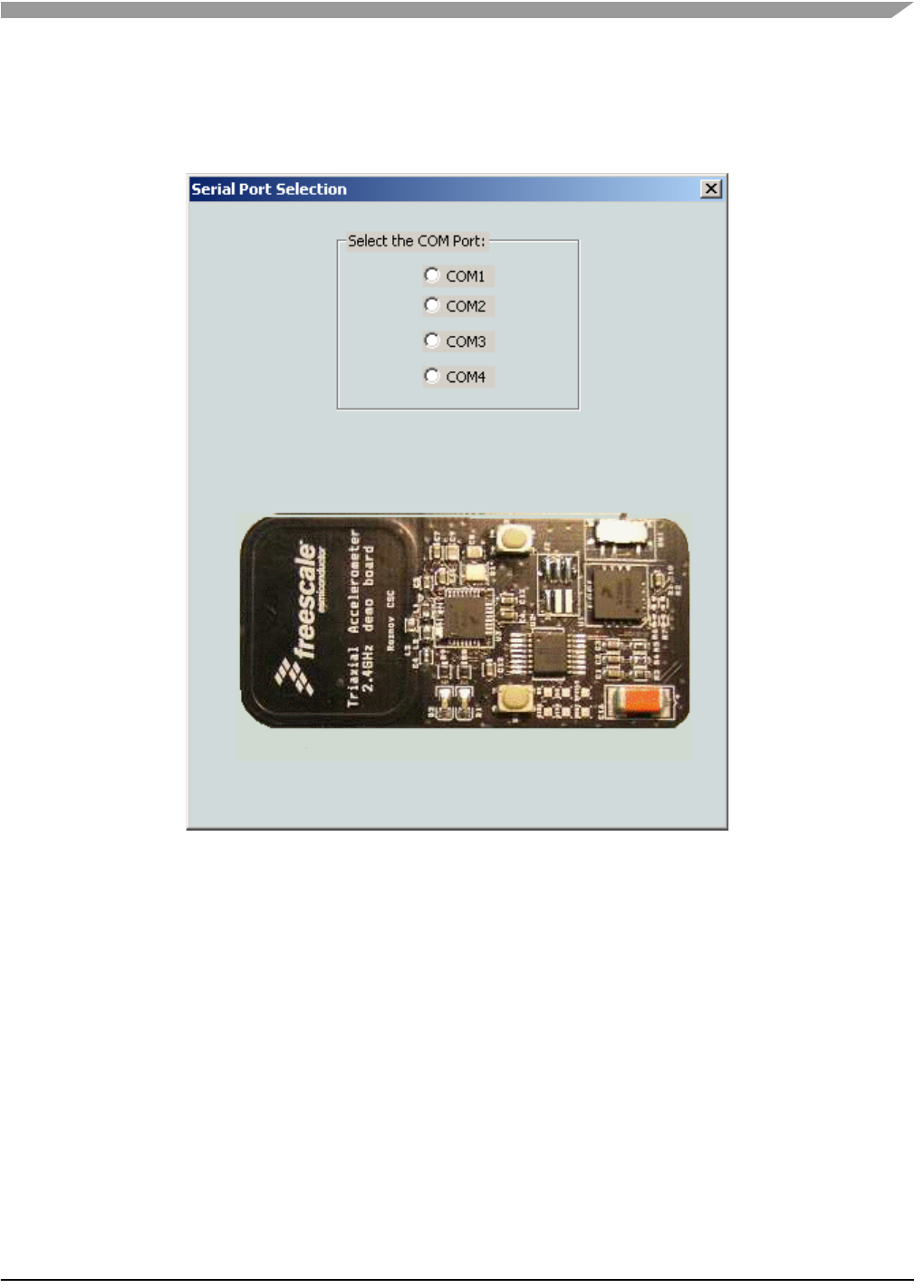
ZSTAR Installation Procedure
Wireless Sensing Triple Axis Reference design, Rev. 0.9
Freescale Semiconductor 59
9. Launch the RD3152 software “RD3152MMA7260QSW.exe" and select the COM port number
which you may have assigned in Device Manager.
Figure 6-1
If no error message appears, the COM port is opened correctly and software communicates with the USB
stick.
10. Now lets go and check data from the ZSTAR Sensor Board.
Raw data, 2D/3D screen, or Scope work should be used for this purpose. While moving (turning, shaking)
with a ZSTAR Sensor Board, data from the separate axis should change accordingly.
The RD3152MMA7260QSW calibration screen can be used for sensor calibration (calibration data is
stored in the Sensor Board).

Application Setup
Wireless Sensing Triple Axis Reference design, Rev. 0.9
60 Freescale Semiconductor
6.1.2 AN2295 Bootloader Drivers installation
This procedure assumes that ZSTAR Demo drivers are already installed. The drivers are alse common
for the bootloader (= are already present in Windows folders). If not, the procedure will be identical to the
ZSTAR drivers installation.
1. Press the Button on the USB stick and insert it into a USB connector (keeping the button pressed
when inserted).
The following window appears:
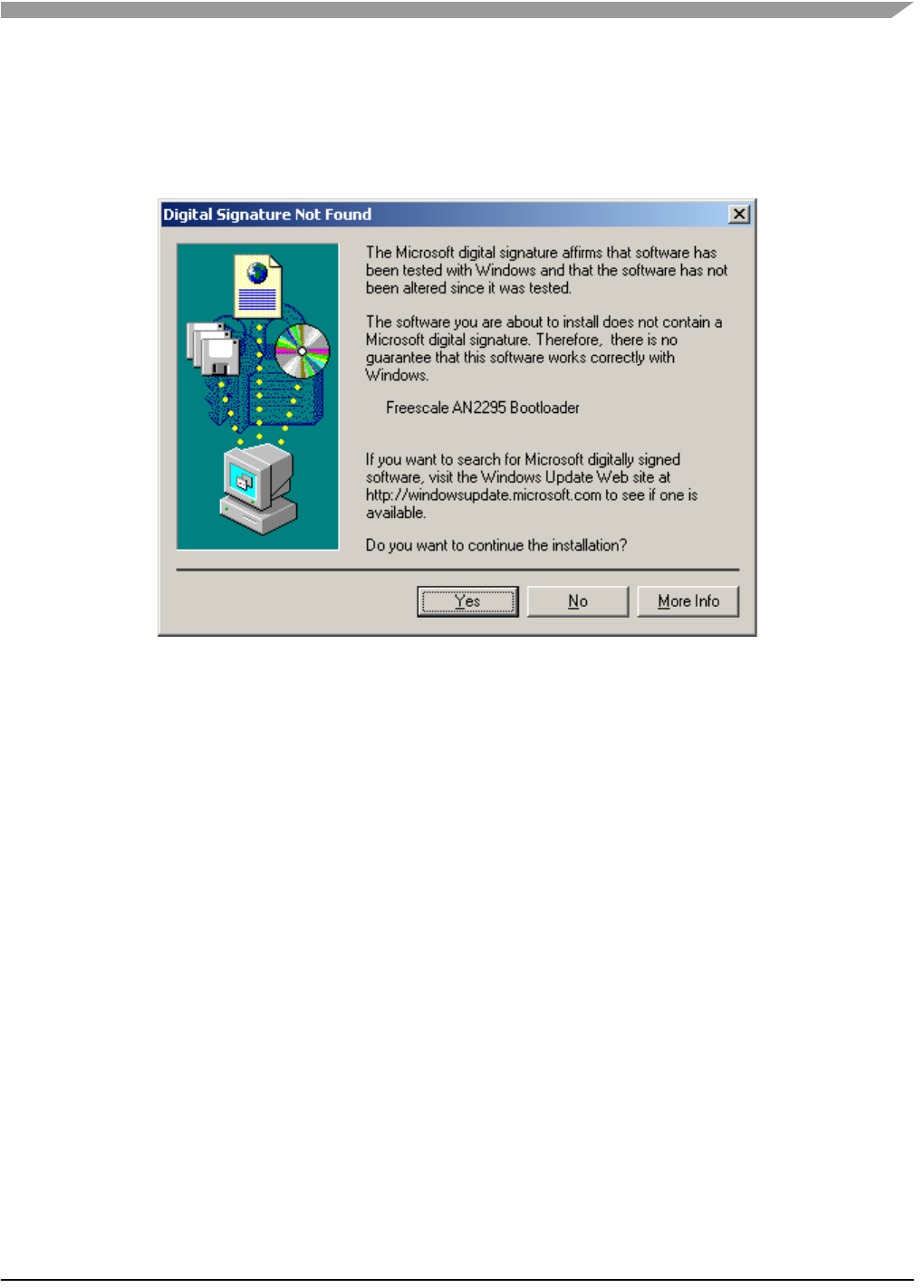
ZSTAR Installation Procedure
Wireless Sensing Triple Axis Reference design, Rev. 0.9
Freescale Semiconductor 61
2. The PC searches for an appropriate driver (as the ZSTAR Demo, in some instances a folder with
drivers (zstar.inf and usbser.sys) needs to be selected), then the following window should
appear:
3. Just click Yes, and the bootloader port will be installed (as seen in the Device manager):
4. Right click My computer on the Desktop > Properties, Hardware tab, Device Manager button.
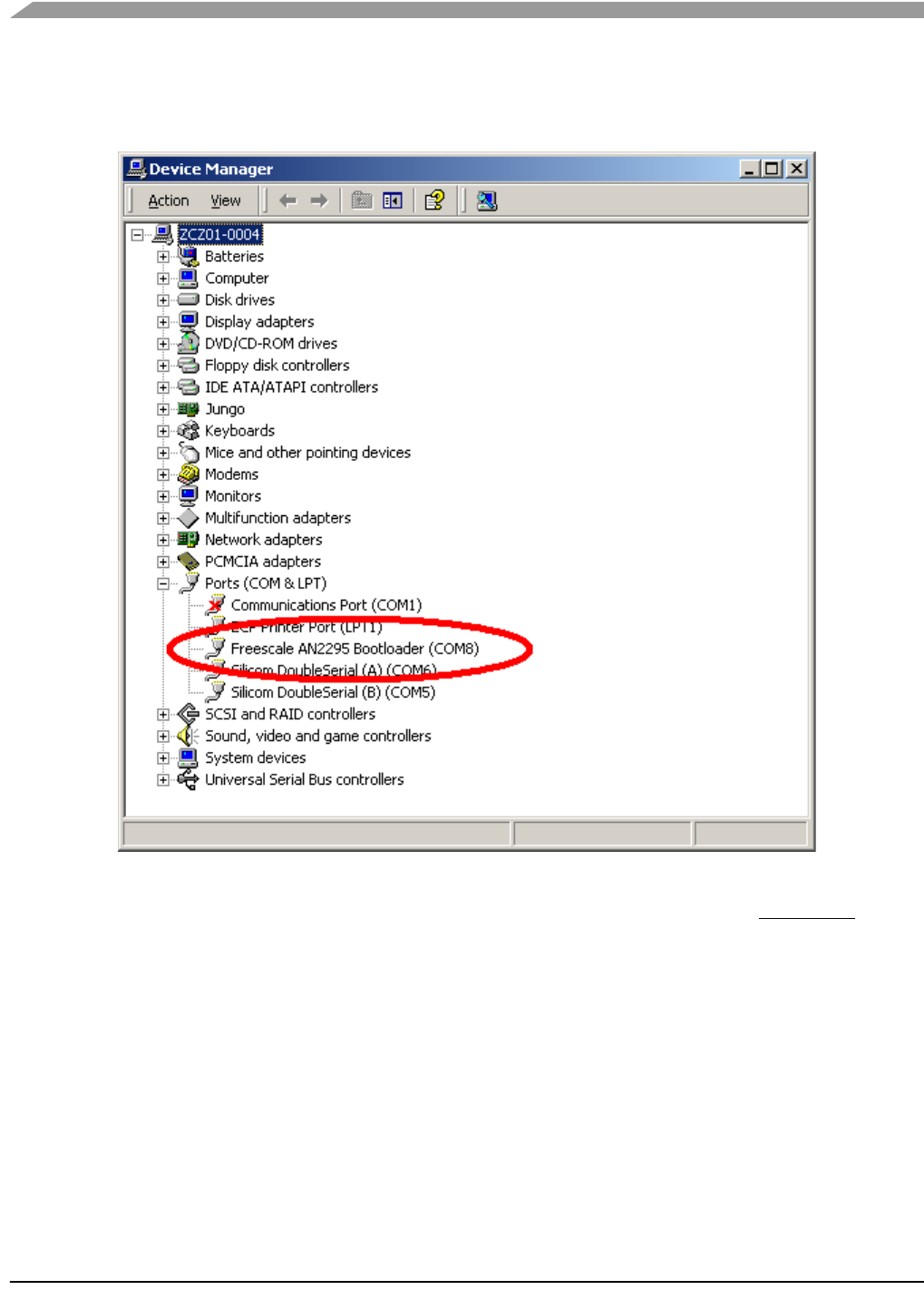
Application Setup
Wireless Sensing Triple Axis Reference design, Rev. 0.9
62 Freescale Semiconductor
5. A similar setup should be observed:
6. Note down the COM port number (here, COM8); this is the port number of the Bootloader
Once the software in the USB stick needs to be updated, the Bootloader can be invoked anytime, just by
pressing the button while inserting the USB stick into the USB slot.

Wireless Sensing Triple Axis Reference design, Rev. 0.9
Freescale Semiconductor 63
Appendix A
References
The following documents can be found on the Freescale web site: http://www.freescale.com.
1. AN2295 Application note - Developer’s Serial Bootloader for M68HC08 and HCS08 MCUs
2. AN3153 Application note - Using the Full-Speed USB Module on the MCHC908JW32
3. MC9S08QG8 Datasheet
4. MCHC908JW32 Datasheet
5. MMA7260Q Datasheet
6. MC13191 Datasheet

Wireless Sensing Triple Axis Reference design, Rev. 0.9
64 Freescale Semiconductor

How to Reach Us:
Home Page:
www.freescale.com
E-mail:
support@freescale.com
USA/Europe or Locations Not Listed:
Freescale Semiconductor
Technical Information Center, CH370
1300 N. Alma School Road
Chandler, Arizona 85224
+1-800-521-6274 or +1-480-768-2130
support@freescale.com
Europe, Middle East, and Africa:
Freescale Halbleiter Deutschland GmbH
Technical Information Center
Schatzbogen 7
81829 Muenchen, Germany
+44 1296 380 456 (English)
+46 8 52200080 (English)
+49 89 92103 559 (German)
+33 1 69 35 48 48 (French)
support@freescale.com
Japan:
Freescale Semiconductor Japan Ltd.
Headquarters
ARCO Tower 15F
1-8-1, Shimo-Meguro, Meguro-ku,
Tokyo 153-0064
Japan
0120 191014 or +81 3 5437 9125
support.japan@freescale.com
Asia/Pacific:
Freescale Semiconductor Hong Kong Ltd.
Technical Information Center
2 Dai King Street
Tai Po Industrial Estate
Tai Po, N.T., Hong Kong
+800 2666 8080
support.asia@freescale.com
For Literature Requests Only:
Freescale Semiconductor Literature Distribution Center
P.O. Box 5405
Denver, Colorado 80217
1-800-441-2447 or 303-675-2140
Fax: 303-675-2150
LDCForFreescaleSemiconductor@hibbertgroup.com
RoHS-compliant and/or Pb-free versions of Freescale products have the functionality
and electrical characteristics of their non-RoHS-compliant and/or non-Pb-free
counterparts. For further information, see http://www.freescale.com or contact your
Freescale sales representative.
For information on Freescale’s Environmental Products program, go to
http://www.freescale.com/epp.
Information in this document is provided solely to enable system and software
implementers to use Freescale Semiconductor products. There are no express or
implied copyright licenses granted hereunder to design or fabricate any integrated
circuits or integrated circuits based on the information in this document.
Freescale Semiconductor reserves the right to make changes without further notice to
any products herein. Freescale Semiconductor makes no warranty, representation or
guarantee regarding the suitability of its products for any particular purpose, nor does
Freescale Semiconductor assume any liability arising out of the application or use of any
product or circuit, and specifically disclaims any and all liability, including without
limitation consequential or incidental damages. “Typical” parameters that may be
provided in Freescale Semiconductor data sheets and/or specifications can and do vary
in different applications and actual performance may vary over time. All operating
parameters, including “Typicals”, must be validated for each customer application by
customer’s technical experts. Freescale Semiconductor does not convey any license
under its patent rights nor the rights of others. Freescale Semiconductor products are
not designed, intended, or authorized for use as components in systems intended for
surgical implant into the body, or other applications intended to support or sustain life,
or for any other application in which the failure of the Freescale Semiconductor product
could create a situation where personal injury or death may occur. Should Buyer
purchase or use Freescale Semiconductor products for any such unintended or
unauthorized application, Buyer shall indemnify and hold Freescale Semiconductor and
its officers, employees, subsidiaries, affiliates, and distributors harmless against all
claims, costs, damages, and expenses, and reasonable attorney fees arising out of,
directly or indirectly, any claim of personal injury or death associated with such
unintended or unauthorized use, even if such claim alleges that Freescale
Semiconductor was negligent regarding the design or manufacture of the part.
Freescale™ and the Freescale logo are trademarks of Freescale Semiconductor, Inc.
All other product or service names are the property of their respective owners.
© Freescale Semiconductor, Inc. 2006. All rights reserved.
ZSTARRM
Rev. 0.9, 3/2006